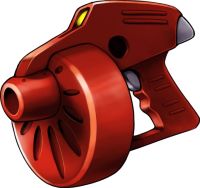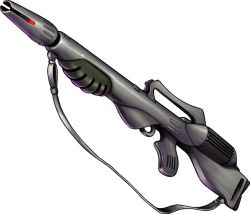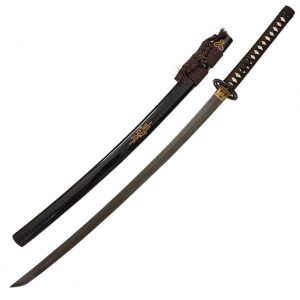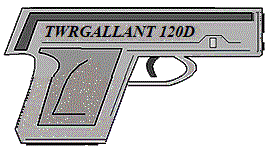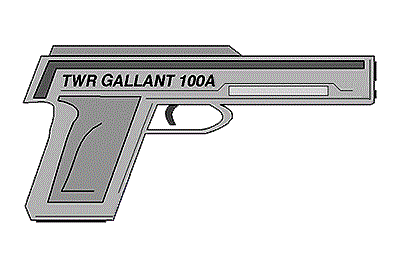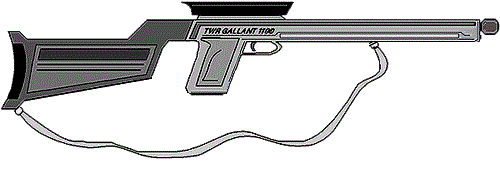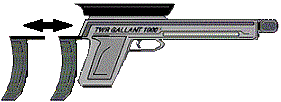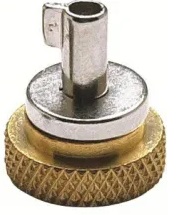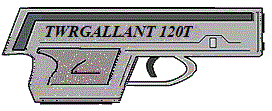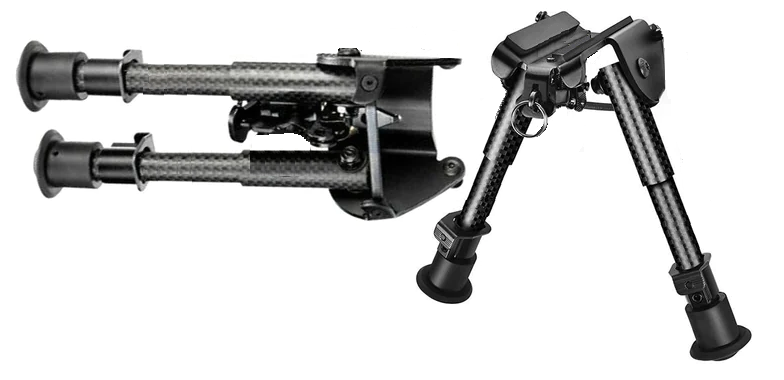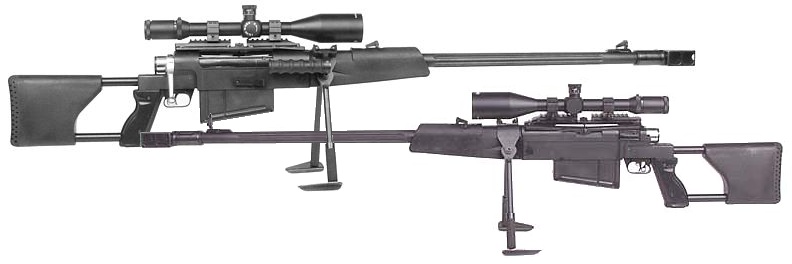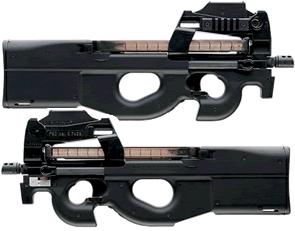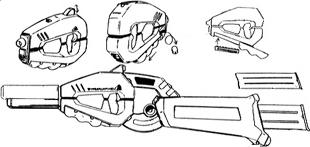 United Galaxies Council. |  United Galaxies Council. | ||||||||||||||||||||||||||||||||||||||||||||||||||
|---|---|---|---|---|---|---|---|---|---|---|---|---|---|---|---|---|---|---|---|---|---|---|---|---|---|---|---|---|---|---|---|---|---|---|---|---|---|---|---|---|---|---|---|---|---|---|---|---|---|---|---|
| Pretty much ALL Robotech Defense Forces-Era Weapons have been supplanted, and even the much-vaunted Gallant H-90 has lost favor in light of advancing technology and shrinking defense budgets. Most of these weapons are based on Terran Global Civil War-era designs, advance to more modern specifications. Another important advance in this area is Plasma-662. Most UGC weapons can be used by Battle Armored or Power Armored Troopers; Only M-2 Machine Gun and PB-22 Particle Beam Cannon are unavailable to Battle Armored Troopers (unless vehicle-mounted or fixed-position). The M-25 Recoilless Rifle can not easily be used by Power Armored Troopers, due to the small size of the trigger guard, unless gloves are removed. Plasma-662: Originally developed by Dr. BURKE, Plasma-662 is essentially unstable hydrogen under EXTREME pressure; Once jostled the right way, it is as explosive as nitroglycerin, but does not damage barrel or receiver; It also burns cleaner than Cordite. The only weapon listed here that is totally restricted (totally banned to civilians in any ways shape or form) is the Steyr-Mannlicher AG Armor Piercing, Fin Stabilized, Discarding Sabot, Anti-Armor Sniper Rifle (APFSDS, or the "Appophis"), due to its INCREDIBLE power. Other items "may" be partially restricted (see text); If no indication it is restricted is given, these can legally be owned by anyone, though some municipalities have internal restrictions. | |||||||||||||||||||||||||||||||||||||||||||||||||||
| Although increasing rare, T'sentraedi weapons can still be found around the Milky War galaxy, most often mounted onto vehicles on in the hands of T'sentraedi Supremist. The capture of the ROBOTECH FACTORY secured control of manufacturing of the weapon to the RDF's control; The factory's equipment was retooled to other weapons, but the blueprints and other technical data was recovered by many groups and as a result are still a threat to UGC affilated forces. | |||||||||||||||||||||||||||||||||||||||||||||||||||
Despite its comparatively compact size the weapon had potent anti-armor capabilities which made it effective against most of the Mecha and vehicles deployed by Local Group powers. However, as the T'sentraedi miliary grew and became more focused on Nousjadeul-Ger and Regults the weapon fell out of favor to the T'sen-Gaur, reverting to a sidearm for backup us. In the aftermath of the FIRST ROBOTECH WAR it saw renewed use as T'sentraedi Malcontents were often were short of weapons of any sort. As time went on and Malcontent weapons improved they fell into less use again, typically being incorporated into rebuilt Mecha. It were still being used in extremely limited numbers as late as the THIRD ROBOTECH WAR. A "cut down" versions to the Druuj-Miguar Pistol have been seen quite a bit, an unsurprising fact considering that a version was tested by the RDF prior to the reconstruction of UES MACORSS and eventually lead to the development of the head lasers used by RDF Mecha and the RDF Heavy Laser Rifle. |
The weapon saw some action during the FIRST ROBOTECH WAR and was heavily employed by Malcontents who often had far less access to Mecha, especially at the beginning. The were also often be found mounted on vehicles (technicals and guntrucks) and as alternative weapons on Moddies. The Warlady Zaria made a point of it to modify her Regults with an external T'sen-Guar mounting bracket in case the Mecha was damaged beyond use. It was powered by a cylindrical energy pack built into the stock of the rifle that contained 157 shots. This pack could be recharged using chargers on T'sentraedi ships. The weapon was designed to accommodate various optics which would be mounted to the top of the carry handle/sight. | ||||||||||||||||||||||||||||||||||||||||||||||||||
| MT-261 Vibro Bayonet/Knife REF Zoitachi Nous-Gran'diel Kah yar | Trati T'sen Kah yar MT-601 Field Tool M-605 Field Torch | ||||||||||||||||||||||||||||||||||||||||||||||||||
| 9MM "Wolf" pistol M-6 Laser Pistol Z-31 Pistol | M-27 Pistol BOS.223 Pistol Garudan Spellcaster | ||||||||||||||||||||||||||||||||||||||||||||||||||
| M-93 Black Arrow Anti-Personnel Sniper Rifle FN P90 "Enforcer" PDW FONTAIN HEAVY Assault Rifle T'luaza Milldiem 281 Model Assault Rifle M-18 Laser Rifle | M-35 "Wolverine" Assault Rifle M-36 "Badger" Sub-Machinegun M-25 Recoilless Rifle RDF M41a Pulse Assault Rifle System AKLU-85 | ||||||||||||||||||||||||||||||||||||||||||||||||||
| The H-1X series represents a major new direction for UGC affiliated weapons; Dedicated purpose driven designs centered around a uniform basic principle. | |||||||||||||||||||||||||||||||||||||||||||||||||||
| Gallant H-120D Pistol Gallant H-100A Pistol Gallant H-1100 Rifle Gallant H-2000 AMS Gallant H-100X Gallant 120T | 53 Plasma Launcher Potential Accessories Bayonets Scope: Bipods Other Accessories | ||||||||||||||||||||||||||||||||||||||||||||||||||
| M-21 Plasma Launcher | M-23 Lasooka | ||||||||||||||||||||||||||||||||||||||||||||||||||
| M-2.50 Caliber Machinegun (aka "Ma Duece") EP-37 60MM Beam Cannon EP-40 40MM Pulse Beam | RL-6 Heavy Rocket Cannon PB-22a Shoulder Particle Beam Cannon M-550d Heavy Particle Beam Cannon (aka "Pa Duece") | ||||||||||||||||||||||||||||||||||||||||||||||||||
| T-21 Multi-Phase Laser Energy Weapon Gallant H-90 Multi-Weapons System | Gallant H-1000 Multi-Weapon System | ||||||||||||||||||||||||||||||||||||||||||||||||||
| Appophis Armour Piercing Sabot Anti-Armor Sniper Rifle | GU-11S 55MM Gun Pod | ||||||||||||||||||||||||||||||||||||||||||||||||||
| As the mobile infantry forces for the Robotech Expeditionary Forces, Cyclone riders are often ordered on rapid strike missions to help take out enemy fortifications and defenses in advance of heavier forces (such as Veritechs and Destroids). The cyclone's incredible mobility made it ideal for these types of missions, but the light armament of the mecha hinders the success of the mission- Often 40-70% of a Cyclone squadron would be destroyed while accomplishing mission objectives, simply because their armament and equipment was not sufficient to the tasks they were faced with. To rectify this, REF engineers began a study designed the "Cyclone Redesign Project" in 2039 in conjuction with REF Intelligence, taking a close look at the capabilities of the Cyclones versus the missions they were being assigned to; Although a marvelous Mecha for reconnaissance, hit-and-run, infiltration, and extraction missions, they were deemed underpowered and underequipped for front-line confrontations with proper combat Mecha. REF engineers designed several different auxiliary units for use with Cyclones to augment their capabilities. The most common of these units are listed below. In motorcycle mode these heavy weapons would be mounted on sidecars that could travel fairly quickly along with the cyclone, and in battloid mode the weapon would convert to an over-the-shoulder unit that increased the offensive capabilities of the cyclone. All HWS units have their own auxiliary internal power supplies so as not to cause any unnecessary drain on the Cyclone's own engine system. There are four ditect combat units and three support units; A missile launcher sidecar developed directly from the HMMDS-6 and -12 Missile Sidecars (in fact the original units were upgraded HMMDS's), a particle cannon similar to the one used by the Excalibur Destroid, a tri-barrel rapid-fire laser cannon similar to the one used by the Raidar X, and a disruptor cannon similar to the one used by Shadow Fighters for combat, a high-density battery pack and reentry shield for intelligence work, and a modified version of the venerated MG-8 Phantom III's LP-5 Suspension Pod designed to fit to the Cylone and motorcyles/hovercyles. Unfortunately due to size considerations, the HWS units use an unshielded protoculture power system that can be easily detected by Invid sensors when active. Furthermore, because of their size and placement, the ground and flight speeds of a cyclone are decreased by 15% while the system is attached. The units can be instantly detached from the cyclone mecha after they have served their purpose. Often one HWS of each type was assigned to a cyclone infantry platoon (12 Cyclone riders) and the three cyclone riders who used them became the heavy weapons squad of the platoon. Note: Some of these can be "mixed and matched," but adding a CA-105 Battery Pack doesn't overcome the greater power burden; It's intended for stealth insertion, and activation of the weapons systems still requires bringing the protoculture drives on line, making the vehicle visible to the Invid. Note: These systems were designed for the Cyclone series Veritechs, but can be used by any motorcycle or hovercycle. Use on the Wyvern Motor/Hovercycle is difficult as the pre-existing lasers would have to be unmounted (requires a field tool kit and preferably a jack, though it has been done with a strong tree branch on many occasions), but is not uncommon (double HosBoxes are normal on Wyverns used by medical personnel, both in the REF/RDF and in the civilian sector). Unlike some other weapons and systems listed here, these can only be used with Cyclones, motorcycles, and hovercycles except the CA-101 Cyclone Re-entry Shield, which be use by any power armor and some hovercycles (though variations on the WB-417 Wing Boards would be far more CA-105 Cyclone High-density Battery Pack. effective). | |||||||||||||||||||||||||||||||||||||||||||||||||||
| HMMDS-21 Missile Sidecar. CA-102 Cyclone Heavy Weapon System: Particle Beam Cannon. CA-103 Cyclone Heavy Weapon System: Tri-Barrel Laser. CA-104 Cyclone Heavy Weapon System: Disruptor Cannon. | CA-105 Cyclone High-density Battery Pack. CA-106 Cyclone Medical Sidecar. CA-101 Cyclone Re-entry Shield. | ||||||||||||||||||||||||||||||||||||||||||||||||||
| A-21 Sniper Scope | GR-117 Rescue Hook | ||||||||||||||||||||||||||||||||||||||||||||||||||
| "Hand to hand" (or "melee") weapons refer to any weapon that has no projectile component, and therefore only applies to the user's own reach. In this regard, the UGC has very few types of such weaps (excluding purely ceremonial). Most are intended strictly as tools, though can be used to harm someone if applied carefully; Only the MT-261 Vibro Bayonet/Knife and the Nous-Gran'iel Kah yar are specifically intended as weaps in their own right. | |||||||||||||||||||||||||||||||||||||||||||||||||||
 A vibro-bayonet/trench knife, can be used as a knife OR as a bayonet. Intended for use on the right side of the M-18 or M-25. It can also be used as a brass knuckle (3 times normal damage, SD or MD), though the grips are primarily intended to protect the fingers of the wielder. These are available on the open market, but stolen cases and knockoffs often show up on the black market. Buyer discretion is strongly advised, especially as this is not a restricted item in any fashion. | The second-generation Zatoichi (developed shortly after the Rain of Death) included a button to hold the sheath in place, allowing it to be used both as a straight handled baton and as a sword and a raised area near the  hilt (where the sheath separates from the grip) to allow it to be inserted into a specially designed frog. It recently came back into service both for it's less-lethal to lethal conversion and for ceremonial purposes by the REF. hilt (where the sheath separates from the grip) to allow it to be inserted into a specially designed frog. It recently came back into service both for it's less-lethal to lethal conversion and for ceremonial purposes by the REF. | ||||||||||||||||||||||||||||||||||||||||||||||||||
| Purpose: Defense Weight: 1.5 lbs Damage: Knife: Normal: 2D6 SD. Powered Up: 2D6 MD. Bayonet: 6D6 MD. Attacks per melee: Normal Effective Range: Reach (+rifle length if used as a bayonet). | Payload: Knife: 5 hours. Bayonet: Hooks directly into the rifle's power systems, drawing 1 shot, which will last it all day (whether the rifle has power or not). Cost and Availability: 500credit; Always available. Black Market Cost and Availability: 50 to 5,000credit, depending on the buyers and seller; Routinely available. | Purpose: Defense/Offence Damage: PS doubled for sheathed, PS converted to MD for unsheathed. Range: Reach plus 4 feet. Payload: Not apllicable. Weight: 1/2 lb. | Weapon Cost and Availability: 200credit; Always available. E-Clip Ammo Availability: Not applicable. Black Market Cost and Availability: 20credit; Always available. | ||||||||||||||||||||||||||||||||||||||||||||||||
| Note: The weapon can come unsheathed in the middle of particularly intense situation by accident, both by the user acciretly pressing the release button and, on occasion, by the target gripping the sheath. When this occurs, the user is supposed to withdraw if sheaths has not been oreder; It doesn't always happen that way, but on the other hand, if these are being used, it's already known sheaths 'might' be called. | |||||||||||||||||||||||||||||||||||||||||||||||||||
 The Vibro-knife developed for the T'sentraedi Nous-Gran'iel has come "in vogue" by some soldiers. Flip out side blades prevent the weapon from going too deep. Mostly ceremonial, but a nice collector's item. |  An exotic weapon developed originally for the T'sentraedi Warrior Corps by the REF to bolster moral; Not necessarily the most practical weap, but still very popular with them AND others (Terrans, Paraxians, and more). | ||||||||||||||||||||||||||||||||||||||||||||||||||
| Purpose: Defense Damage: Punch Damage+1D4 (SD or MD). Range: Reach. Payload: The E-clip can keep the weapon charged continuously for up to 24 hours. Weight: 1/2 lb. | Weapon Cost and Availability: 50credit; Always available. E-Clip Ammo Availability: 10credit; Always available. Black Market Cost and Availability: 25 to 150credit; Always available. E-Clip run about 10credit and are also always available; A recharge runs around 3 or 4credit each. | Purpose: Offense/Ceremonial. Damage: 6D6 SD or converts SD to MD. Range: Reach +3 feet. Payload: Unlimited- No e-clip, etc. Weight: 1/2 lb. | Weapon Cost and Availability: 100credit; Always available. E-Clip Ammo Availability: Not applicable. Black Market Cost and Availability: Same. | ||||||||||||||||||||||||||||||||||||||||||||||||
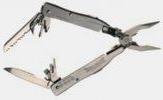 A combination of pliers, wire cutters, Phillips and Flathead screwdrivers, can and bottle opener, scissors, survival knife and saw, file, LED Flashlight, and it floats, TOO! Usually found in survival kits. Really NOT intended as a weapon. |  A simple and reliable pen torch. Used for lighting fire, repairing armor, and occasionally to scare off small animals. Usually found in survival kits. Not really intended as a weapon. | ||||||||||||||||||||||||||||||||||||||||||||||||||
| Purpose: General purpose tool Weight: About 8 oz. Damage: 2D4 SD when used as a weapon. Attacks per melee: Normal. Effective Range: Reach. | Cost and Availability: 50credit; Always in stock at the nearest Exchange and stores everywhere. Black Market: Not available; Sold openly on the market, in supermarkets, tool stores, even toy stores. | Purpose: General purpose tool Weight: About 8 oz. Damage: 2D4 MD when used as a weapon. Attacks per melee: Normal. Effective Range: Reach. | Cost and Availability: 10credit; Always in stock at the nearest Exchange and stores everywhere. Black Market: Not available; Sold openly on the market, in supermarkets, tool stores, even toy stores. | ||||||||||||||||||||||||||||||||||||||||||||||||
| There are literally millions of other weapons, some for special duties or purposes. Swords in particular have very limited battlefield utility, but are still issued for ceremonial purposes have have been used on the field to kill and injure- Rarely. While in no way an all-inclusive list, here are a few: | |||||||||||||||||||||||||||||||||||||||||||||||||||
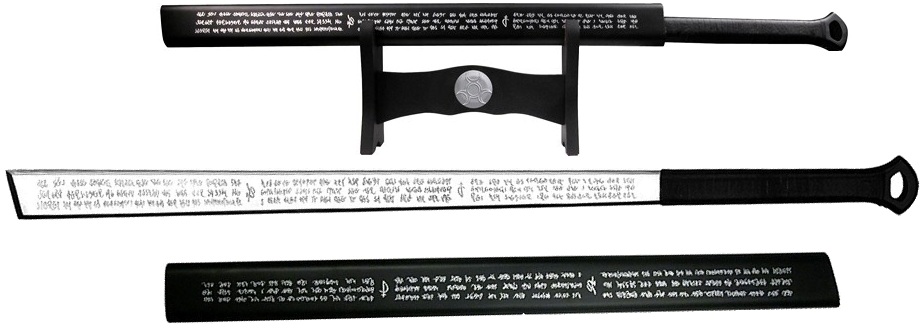 This sword, made specifically for the Paraxians by the T'sentraedi Female Warriors, was made based on a sword from a Terran move, UltraViolet, which was popularized among them. (It was about some vampire slut who kills a rival.) The Meltraedi, as female T'sen are sometimes called, had them around for decorative purposes; The Paraxian 22ND Cyclone Infantry adopted them as their official sword. Features a 29.5" stainless steel blade. The faux wood, hard plastic handle is accented with tightly wrapped cording. Includes sheath. 41.5" overall. |  A falchion is a Medieval one-handed, single-edged sword of European origin, developed from farmer's and butcher's knives or from combining axes and swords (combining the weight and power of an axe with the versatility of a sword). The blade designs of falchions varied but always included a single edge with a slight curve on the blade towards the point on the end. They were commonly used as tools when not as weapons. These swords were produced in their hundreds by blacksmiths. They were generally made from iron with steel edges. With this in mind, they were adopted by the Carbonarans as the sword used by Carbonaran Defense Forces. | ||||||||||||||||||||||||||||||||||||||||||||||||||
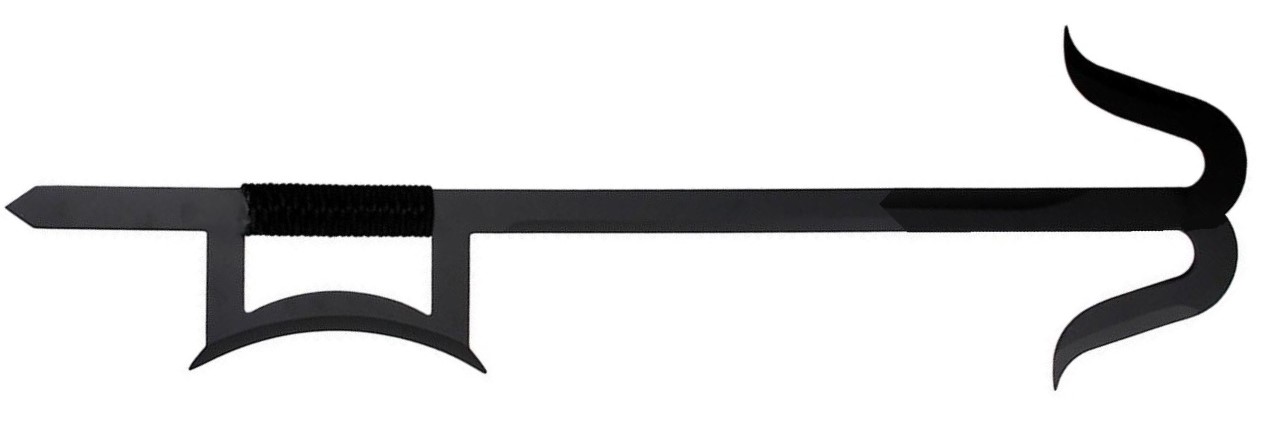 Few swords are more intimidating or more effective than the two handed Chinese War Sword-inspired Perytonian War Sword. Its huge, wide blade will shear through armor as if it were butter, not to mention mere flesh and bones. There is nothing clumsy or awkward about this sword. Its 14" cord wrapped grip, "S" shaped guard, and steel ring pommel all work in concert to make it a well balanced weapon that's unbelievably fast and agile. 23.25" blade, 37.75" overall. | 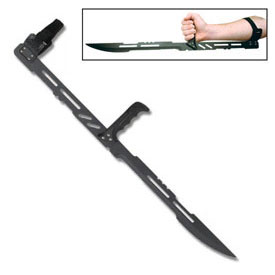 One solid piece of hard anodized black stainless steel stretches an amazing 17.5" long. Unlike any other sword in its class, this hi-tech offers a handle with firm gripping power; Simply strap it onto your arm and grab the handle. The Garudan Defense Forces adopted this sword, which is made from blades milled off-planet, from metal smelted off-planet, but from metals MINED on-planet and sharpened on-planet by the soldiers themselves. | ||||||||||||||||||||||||||||||||||||||||||||||||||
| Not just a weapon, but the soul of bushi, the Katana is the traditional Japanese longsword (Dait0). In use after the 1400's, the Katana is a curved, single-edged sword traditionally used by the samurai. When the Katana and Wakizashi are worn together, the pair of swords were called Daish0, which translates literally as "large and small." The Katana was often called the sword or the long sword and the wakizashi the companion sword. More pragmatically, the REF katana blade was used in the REF Zoitachi. Length: 20 inches. |  | The Wakizashi (meaning "side arm") is a traditional Japanese sword with a Sh0t0 blade between 12 and 24 inches (30 and 60 cm), with an average of 20 inches (50 cm). It is similar to but shorter than a Katana, and mostly shorter than the Kodachi ("small sword"). The Wakizashi was usually worn together with the Katana by the Samurai of Japan. It is the middle sword here (the Katana is the bottom one). Length: 15 inches. | |||||||||||||||||||||||||||||||||||||||||||||||||
Wakizashi Katana | |||||||||||||||||||||||||||||||||||||||||||||||||||
 This is a small Japanese knife from the same steel as the Katana and the Wakizashi. This knife was sometimes worn instead of the Wakizashi. The Japanese version was mostly ceremonial in purpose, but in the REF they are routinely issued to all infantry and combat zone non-infantry as a quick weapon you can safely sleep with; More than one REF Infantryman has been caught sleeping with this weapon in his hands. More pragmatically, the REF Tanto combines the blade of the ancient Tanto with the split-knuckle grip of the trench knife (this isn't the MT-261). Length: 6 inches.  It should be noted every empire the UGC has had contact with issues some version of this weapon to their warfighters; The split finger design of the REF is a little more rare, but not that exceptionally. So common is this basic concept that the REF began simply shipping their version in to the allied forces without even bothering to ask if they are wanted; Most accept the knives and issue or sell them to members at actual cost (in other words pennies on dollar), so the universe is pretty much flooded with them, and noboby's yet noticed the diffrence. |
The Uchigatana is a Japanese blade and predecessor of the katana, considered the "soul of the Samurai." Its long blade and sharp edge made it ideal for use on horseback. The Uchigatana the uchigatana was worn edge-up in the belt. This sword was developed out of the ever-increasing need for speed on the battlefield, where quickly unsheathing one's sword and cutting down the enemy was a matter of life or death. Since it was shorter, it could be used in more confined quarters, such as inside a building. Unlike the tachi, with which the acts of drawing and striking with the sword were two separate actions, unsheathing the uchigatana and cutting the enemy down with it became one smooth, lightning-fast action. Because the sword is being drawn from below, the act of unsheathing became the act of striking. The of the uchigatana was essential since it allowed the sword to come out of the sheath at the most convenient angle for executing an immediate cut; Since the uchigatana's re-adoption by REF Heavy Calvarly this returned in spades, since Cycloners and Dragoons are routinely ambushed in combat zones and can't use their rifles and ride effectively. Length: 30 inches. | ||||||||||||||||||||||||||||||||||||||||||||||||||
| All of the non-firearm items listed here are manufactured by contractors for the REF; The REF encourages them to openly sell to their products to the public for profit and provides various subsidies to keep these contractors in business, as long as they make sure the REF gets their orders filled FIRST. They do so without UGC specific authorization under "Continuous Contract Support" line items in the budget. Thes subsidies include paying for new factories, partial production line buys, and on occasion direct cash payments to help keep them afloat. The REF needs those contractors a lot more than the contractors need the REF; The REF is therefore very open to negotiation. Other contract items however will vary accordingly. | |||||||||||||||||||||||||||||||||||||||||||||||||||
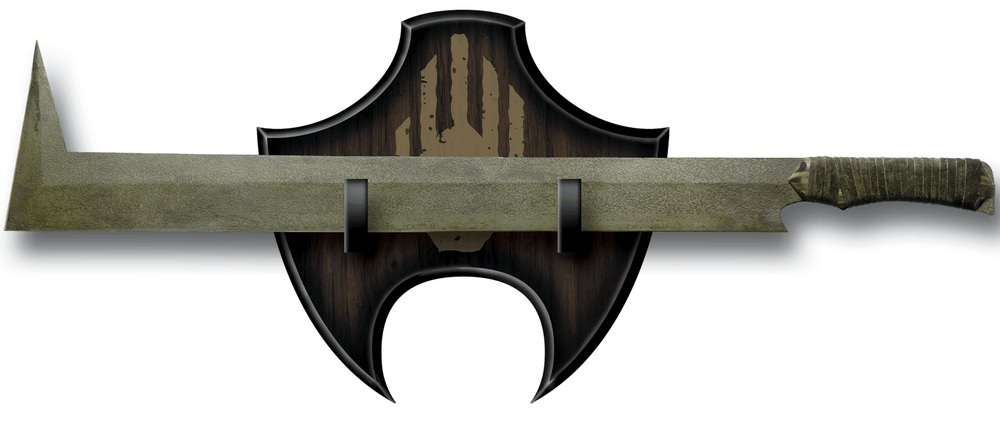 The Urik-Hi kept their traditional sword after their entry into the UGC; The (highly contested) exempt status with the REF not withstanding, they do have the right to a Defense Force. Length: 31 inches. | |||||||||||||||||||||||||||||||||||||||||||||||||||
| Small arms are generally intended either as backup weapons, or are used by those who do not expect during the ordinary course of business to get into a battle but are cognizant that it could happen (such as law enforcement/militry police). | |||||||||||||||||||||||||||||||||||||||||||||||||||
The success of the wide variety of UGC Militry weaps varies greatly; Some worked out completely (such as the H-90 and -1000), others effectively failed (such as the T-21). Others worked only after various modifications (such as the M-35 and -36). This led to logistics issues which the Council and the Senate in particular wanted resolved; The UGC wants a uniform system with as much commonality in designs as possible to save money, since 5 factories manufacting the same product for all the branches of the REF and RDF's can produce up to 5 times as much, at generally slightly under the cost of 4 factories producing 4 different products to the particular specifications of one or two services. When the T-21 program imploded, specification G8 Energy Weapons System was issued by the REF for their next generation basic infantry weapons. This required there be multiple energy settings, able to use standard energy cells (not reliant on protoculture which even with Invid cooperation was a scarce resource), a sidearm that could be compatible with a detachable stock for pilots, a long arm for standard infantry, able to use secondary weapons including bayonets, plasma and grenade launchers, and breacher weapons, the pistol magazine had to be compatible with the rifle for emergency use, the rilfe mag had to be compatible with the detachable stock for evasion and rescue use. TWR took their tested but never battle proven H-1000, tweaking it to meet the specifications by fixing the stock and stretching the barrel on the 1000 to form the rifle and shortening the barrel to form the pistol; As a final touch to the receivers, they removed the forward handguard that many militry and police had commented on (it required a special holster that made sitting difficult and concealment impossible). The stock was reconfigured to eject the rifle mag out the front of the stock allowing the user to stay on target, the safety selector was altered to allow the user to bypass the power setting by using additional pressure on the trigger. In a move that exceeded the REF's specification, the H-1X was designed with a "Signal Setting" that allows the weapon to be used as a signaling and targeting system. The standard MRA 6 radio can be linked to the gun allowing it to serve as an emergency transmitter, though morse code is simpler (and excessively complex messages can cause the emitters to burn out quickly). Alternatively, the gun can be used to highlight a target for laser guided munitions or for other friendly forces to identify which target the ground forces are focusing on. The final change involved power output in the rifle variant; By setting the safety selector to maximum, the rifle could be used as a light armor penetrator, at the cost of revealing the shooters location and fully draining both batteries. Tirisian Weapons Research (TWR), the company that developed the Gallant H-1000, reconfigured the ancient protoculture powered design with newer standard energy cells, removed the clumsy and often counterproductive handguards, and most importantly (to some at least) re-designed the safety/trigger system; Now setting the gun to one level doesn't prevent the other levels from being used, but more force has to be applied to the trigger to get it back to the higher levels. The whole of the program as it stood at the time allowed the development of a dedicated heavy energy weapon, the H-2000 Anti Material System. The H-2000 was conceived to be the energy equivalent of a bazooka or other rocket launcher, and field testing proved it cold handle everything the services could ask of it, but REF Army brass felt the system simply wasn't really needed, and the project was initially shelved; However, TWR held the blueprints and tooling equipment to get H-2000's into production quickly if so asked. As a final touch, the guns can be used as cutting and welding torches, though very clumsily; The muzzle has to be put about 1 inch from the metal to be welded, then set to stun only and held down. It will weld or cut at about 1 inch per minute (5 inches per shot), and is only intended for emergency use (-15% to applicable skills, though this can be overcome by a second operation at the same penalty). This wasn't an accident, the lead engineers Dave DEITRICH and Chris MEADOWS, intentionally designed the gun that way. However, because it wasn't in the Specification, they didn't mention anything about it until after the first few guns were fully fielded, then 'casually' demonstrated using an H-100A in exactly this capacity; Reactions were mixed. REF Army officials were duly chagrinned and impressed in the teams ability to 'sneak in' this last little trick, while Marine officials embraced it. Spacy officials insisted on testing the gun's ability to be used as a welder before certifying it for use, while Patrol officials simply began testing it right away. The Areo-Space Force officials refused to even allow it to be tested, and began jotting notes to prohibit the use of the gun as a welder on the spot. Despite (or perhaps because of) the miltry use intentions of the UGC, TWR hopes to find markets in the civilian sector, and so far hasn't been disappointed. The adoption of the H-100A by many police departments has led to wider acceptance by civilian buyers, leading in turn to general acceptance by the National Guards and Militias. The Council has remained generally silent on the matter, but REF MAF JCOS has openly promoted it. Taking an official stance on the matter without the Council's permission would normally have led to the Charman (then REF Marine General TIHUNIS Valhowl) to be removed from his post or even discharged; Instead no action was taken (though it was discussed). This was strongly influenced by all of the members supporting her position publicly; The news media made a point of it to declare "and Spaceways Patrol Admiral Ron JELLICO," which encouraged the Council to address the matter of whether the Patrol was or was not part of the militry (2 weeks later the Joint Session Steering Sub-Committee approved a resolution declaring the Patrol "the oldest continuous branch of the UGC militry"). The H-1X series is on track to fully replace the REF and RDF's infantry weapons inventory, though the extent of the UGC makes implementation difficult and it is estimated it will take 2 to 4 years to fully do so. The H-1100 in first in line, with progress in this going extremely well, and within 6 months 75% of the new guns had been issued, with the remaining 25% actively in the field and the guns take out of service elsewhere being rushed to war zones in case they might be needed. The H-110A is next in line, and this is going roughly as well, with 50% of the guns in service having been replaced. Both weapons are on track to be fully replace withing the year. The H-120D is delayed, in part because M-27's are so much more commonly issued- Militry Police and Medical Corps are especially delayed, since MP's are issued M-27 as 'off duty' weapons and Medical personnel are often not issued anything else unless specifically assigned
Components for the various weapons are 99% interchangeable with each other, except the housing. Capacitors for the H-120D are the same as the H-2000, the trigger for the H-1100 is exactly the same as the H-110A, the safety locks for the H-110a is exactly the same as the H-2000, the focusing rings for the H-1100 are the same as the H-120d, etc. What changes is the number of some parts used (the H-2000 has only one safety lock pin, though the rest is exactly the same), and that the power leads for the H-100A stock are much shorter than the H-1100 (and thus must be unsoldered to swap a -100A stock to a -1100). The receiver housings are not interchangeable, though the H-100A and -1000 stocks can be used on each other and on the -2000 for the E-cli well (the H-2000 e-clip well can be used on the -110A and -1000 as a stock, but uncomfortably). A late comer to the H-1X family is the H-100X, a dedicated School Resource Officer variant. The H-100X took the H-100 frame, then added a extending stock that can be engaged when the weapon is shifted from safe to fire. The H-100X does not have a stun nor signaling mode, and in fact only has an MDC mode- The reason being, when a school or other "protective environment" is threatened the rules go out the window (per MORINMOIR v. UGC), and School and Hospital Officers in particular have no obligation to "play fair." However, a 45 degree arc of stun energy can be emitted as well, with a 25% chance of partially stunning those around the intended target (half all APM). The danger with the wide-angle stun setting is discussed in Gallant training; It can prevent a victim from self-treatment and crawling to safety, and users are specifically instructed to consider this before firing. Additionally, in a life saving technology-rich environment (such as a hospital) the stun setting can interfere with the equipment, especially highly sensitive ones. As such, Gallant recommends against using the stun setting in hospitals at all. The H-100X can use a handcuff key as the safety (particularly a special type with a built in magnet used for training) for the Schools variant. NOTE: The H-1X System does not use protoculture. There is a conversion kit to allow it to do so, but this is a 5,000 credit kit and simply put isn't worth the trouble. The last member of the family is the H-120T, which was developed only to prove it could be done in a derringer format. While Gallant specifically refuses to allow the 120T to be manufactured, certain parties do anyways. These parties include black marketeers, the GIB, the OHS, and the Prison Authority. The limited capacity and damage of the -120T is more than made up for by concealability. The GIB in particular has dropped several hundred thousand behind enemy lines for use by pro-UGC groups (such as San Angele's Moon 44's now disbanded "Committee Of Colonial Matters") like the FP-45 Liberator of the Terran Second World War to mixed results in actual application. The Gallant H-90 will continue to be issued to fighter, bomber, and Veritech pilots but in decreasing numbers as the Gallant H-100A pistol takes over. | |||||||||||||||||||||||||||||||||||||||||||||||||||
The H-120D Sub-Compact is essential a cut down version of the H-110A. The shorter barrel and smaller grip make it handier in most situations to employ quickly (ie, quick draw situations) and easier to conceal. It was intended for second-tier applications, self-defense, and as a backup weapon. The H-120D's e-clip will not work in any other model, but the H-110A's e-clip will work in the -120D's (and the -1100). The grip of the H-120D is slightly shorter than a human male's hand, so with the standard e-clip in place the pinky is unsupported; Most users find this at most annoying until they begin shooting. However, because the -110A's e-clip was designed to the human hand size, inserting a -110A e-clip gives the pinky something to connect to. A sleeve that can go over a -110A e-clip gives it the same feel as a -110A, making it more comfortable still, but is not strictly speaking necessary and is often not used (using the sleeve on a -110A e-clip in a -110A makes it impossible to insert). The H-120D will be going into service, but the -1100 and -110A have been given much higher priority since those are the main infantry weapons at this time. Due to these delays, the M-27 will remain the REF's secondary sidearm, mostly issued to those who should expect not to be in combat but may find this expectation wanting (most notably Militry Police and forward deployed Medical Corps) for a few years still. Many manufacturers around the galaxies are bidding to join the program, and the issue is expected to be fully resolved within 5 years. Note that the H-120D can not use a scope nor a stock; The weapon was intended for immediate self-defense and with concealment as a priority, adding these capabilities would completely negate concealability and add to the costs involved (neither of which is desirable). The H-120D can not connect to a radio, and can only be used for signaling by morse code. It can however connect to a PDA and from there to smart glasses or other stations. |
The H-100A is the pistol component of the system, intended for immediate self defense. The older H-1000 stock is compatible with the sidearm, but the new generation of stocks uses a forward ejecting energy cell allowing the shooter to stay on target. The barrel length was reduced by about 25% to improve holstering options and concealability. TWR ceased development on the H-1000's extended barrel, but by some oversight didn't redesign the barrel to prevent using the older style extension, and as such it's still possible to put in place. The H-100A is seeing growing acceptance outside of the REF and RDF's with police and security and militry contractors, and growing interest in the strictly civilian community. Unlike the H-120D, the H-110A can use a scope, though this is not generally done since the weapon is so relatively small in pistol mode (it's more common in carbine mode). The iron sights are not flip up, the scope clamps directly to the rear sight itself. Converting an H-110A stock to an H-1100 stock requires disconnecting the power leads at the e-clip prongs, removing these and the adapter plate at the forward of the stock, putting the -110A stock onto -1100, connecting the power leads for the -1100 to the prongs, and re-installing the bolts to close it up. The process is not terribly complicated and can take as little as 5 minutes with experience, and greatly improves the chances of UGC militry personnel keeping guns in the fight for as long as possible. The reverse is slightly more complex, as it requires the adapter plate to be present, but if an adapter plate is present then there's really no problem; The longer power leads from the prongs to the capacitors can be used as is with insignificant loss of power. | ||||||||||||||||||||||||||||||||||||||||||||||||||
| Weight: 12 oz (0.34 kg). Damage: By Setting: Setting 1: None, signaling only. Setting 2: Stun; 100% chance of stunning anything under 300 lbs. (16 to save). Larger targets can still be stunned, but it requires rapid deployment (1 shot per 400 lbs. in total weight). Setting 3: 5D6 S.D. per shot; 15% of stunning someone in MDC armor. Setting 4: 3D6 M.D. per shot. | Range: Setting 1: Up to 10 miles, but does not injure or damage. All other settings: 500 ft (610 m). Rate Of Fire: Per user's attack per melee. Payload: By Setting: Setting 1 and 2: 100 shots. Setting 3: 50 shots. Setting 4: 8 shots. | Weight: 2.5 lbs. (1.1 kg); 4 lbs. with stock. Damage: By Setting: Setting 1: None, signaling only. Setting 2: Stun; 100% chance of stunning anything under 300 lbs. (16 to save). Larger targets can still be stunned, but it requires rapid deployment (1 shot per 400 lbs. in total weight). Setting 3: 5D6 S.D. per shot; 15% of stunning someone in MDC armor. Setting 4: 3D6 M.D. per shot. Setting 4: 5D6 M.D. per shot. | Range: Setting 1: Up to 10 miles, but does not injure or damage. All other settings: 2000 ft (610 m). Rate Of Fire: Per user's attack per melee. Payload: By Setting: Settings 1-3: The SDC laser draws so little power that it is effectively unlimited. (roughly 1,500 shots estimated). Setting 4: 4 shots, or 12 with Rifle Stock. | ||||||||||||||||||||||||||||||||||||||||||||||||
An essential element of G8 Energy Weapons System was to bifurcate sidearms from longarms, dedicating the long arm version to infantry use and others who should expect combat. With this in mind, TWR began reworking the barrel segment of their H-1000 series into a long version with more focusing elements. The longer barrel in turn allowed them to add more capacitors as well, increasing the capability of the weapon. The H-1000 was designed with a detachable stock that was permanently installed to the H-1100 allowing the system to decrease energy lost in transference (though an older H-1000 stock can be used on an -1100 as a replacement part if absolutely necessry). This simple change increased the effective capacity of the rifle sized e-clip by 25% without modification, and since the stock is not supposed to come off (for storage in space restrictive bags), the e-clip itself could be redesigned to be 25% energy, giving the H-1100 a 50% increase on capacity right there. The H-1100 does have a few issues unique to it's design; The maximum effective range (1 mile) is far greater than the capabilities of 90% of the species of the UGC (about 200 yards), meaning the scope must be used to employ the rifle to its maximum effect. The weapon has back up iron sights (maximum effective range 200-250 yard) which can be supplemented with holoscopic enhancers (maximum effective range 300-500 yards), but the stun setting can't be effectively employed beyond 150 yards without a scope, limiting the effectiveness of the weapon for law enforcement beyond that range. Typically it will only be used beyond a few dozen yards by law enforcement by snipers, and in that capacity will be set to stun (though that can be overridden by a harder trigger squeeze). Scope System: The H-1100 has a scope mounting system, which was complimented by the Fr18a Computer Accurized System, but it's not required. The flip up iron sights have a holographic sight enhancer, but using the enhancer isn't necessary. The forward sight will flip up or down with the rear sight. The flip up sights must be down to use any scope. A properly installed Fr18a can tie to the gun in Signal Setting, allowing the user to send a very complex message via laser signaling, though it will interfere with shooting (it works a lot better than the H-100A though). The scope automatically links to the users personal data assistant which in turn can be linked to smart glasses, visors, heads up displays, or even other stations, so the shooter will automatically see exactly where the barrel is pointed as both an inset image (seeing what the scope sees) and as a recital on the display (showing where the barrel is pointed). A bayonet lug allows the gun to mount any other secondary weapon, be it grenade or plasma launcher, breacher weapon (such as a 12 gge shotgun or similar), good old fashioned bayonet, or other. The H-1100 has a unique fifth setting that completely drains both power cells in one shot, giving it limited armor penetrator capability at the cost of being totally disarmed (at least for a moment) and revealing the shooter's position; The beam is so powerful that it creates a bolt of lighting (ionized air) that gives others the exact position of the shooter to trace back. This effect shows as a white glowing line in a clear atmosphere (such as the majority of Terra), with discolorations caused by atmospheric particulates (excess humidity creates a green tinge that increases in intensity as the humidity rises to a fully green beam at 150% humidity; sand and dust usually creates a blue tinge; smoke and smog oddly creates a yellow tinge, unless leaded fuels are used, in which case the tinge is generally orange, with the balance of red and yellow dependent on the degree of leaded smog present). Each use of the Armor Penetrator setting will cause a 2+(1 per shot)% chance of catastrophically damaging the gun (50% of a 4D6 HP damage to the shooter, not SDC) unless it's allowed to cool for 1 minute (4 melees) between each subsequent shot (even if a lower setting). To use the AP Level, switch the selector to AP (fully slid back). The AP mode has a block like the Safe Mode that prevents the weapon from being used this way unless the shooter deliberately intends to do so. |
The whole of the program as it stood at the time allowed the development of a dedicated heavy energy weapon, the H-2000 Anti Material System. The H-2000 was conceived to be the energy equivalent of a bazooka or other rocket launcher, and field testing proved it could handle everything the services could ask of it, but REF Army brass felt the system simply wasn't really needed, and the project was shelved indefinitely; However, TWR held the blueprints and tooling equipment to get H-2000's into production quickly if so asked, which came weeks later as the REF Marine and Patrol requested it. Unlike the H-1100, the H-2000 doesn't produce anything visible to the naked eye for most species; The H-2000 was in fact first conceived because of this design defect. It can be detected by infrared systems, but only briefly and only if the sensor is directly pointed at the beam. The loading mechanism can hold two standard H-1100 e-clips, allowing multiple shots (which still eject forward, thus into the shooter's back), but is better used in conjunction with an e-cable or using the H-2000's e-clips (e-clips on the H-2000 automatically eject when empty; when H-1100 e-clips are used, they will eject one at a time). The shoulder pad is adjustable, though testing showed most users preferred the position shown here. Regardless of where the shoulder pad is located, the weapon is generally rear-heavy, despite the very long muzzle end. The H-2000 also requires a cooldown, but significantly less than the H-1100 (1 melee action), and the overheat rate is much lower (1% every 4th shot). A bipod can be used, but is not standard. As with all the other H-1X System weapons, the H-2000 can be used as a laser signaler, but much more efficiently; The weapon has an installed antenna connection for the MRA 6, without needing to install the scope. The scope is still needed to put the beam on target, but the weapon can be used in this capacity without it. The beam is powerful enough to reach intermediate orbit (where UGC militry craft would sit during most combat operations) with a good chance of a full message reaching. The antenna connection is on the right side of the receiver, just forward of the trigger and halfway up the body of the gun. The trade off to this is that the H-2000 only has those two settings: Signaler or weapon, there is no in between. Additionally, the H-2000 can not use pistol e-clips under any circumstances- It doesn't even have an e-clip well to fit one into. Additionally, some users describe the automatic ejection of the e-clip as "uncomfortable" or "distracting," while others described it just as attention getting (thus reminding them to reload). Another 'trade off' is the inclusion of the original H-1000 style hand guard; Concealability for this weapon is completely impossible (resting on its butt the weapon is as tall as an average Terran male's shoulders), and the hand guard gives a good purchase point for a second hand (though it's not required). Scope System: The H-2000 has a permanently mounted Fr-31x scope. Using the H-2000 without the scope is possible, but past 250 yards is very difficult (-5 strike). On the plus side, the Fr-31x allows the user to see a starship in mid-orbit, which was entirely the point anyways (to use the -2000 as a signaling system for ships in bombardment and assault modes). Bipod System: The H-2000 was originally conceived with a dedicated integral bipod system, and the initial production run in fact had them installed. However end users (especially Patrol member) began in very short order to remove them citing various reasons. With Block II on, the bipod was no longer integrated, but the fitting to do so were not modified and as such a bipod can be installed rather easily if one has the ports (which are ubiquitous as they were developed specifically from airsoft and other war gaming designs). | ||||||||||||||||||||||||||||||||||||||||||||||||||
| Weight: 6.0 lbs. (2.7 kg). Damage: By Setting: Setting 1: None, signaling only. Setting 2: Stun; 100% chance of stunning anything under 300 lbs. (16 to save). Larger targets can still be stunned, but it requires rapid deployment (1 shot per 400 lbs. in total weight). Setting 3: 5D6 S.D. per shot. Setting 4: 3D6 M.D. per shot. Setting 5: 5D6 times 10 M.D. per shot. Range: Setting 1: Up to 10 miles, but does not injure or damage. All other settings: 2000 ft (610 m). Rate Of Fire: Per user's attack per melee. Payload: By Setting: Settings 1-3: The SDC laser draws so little power that it is effectively unlimited. (roughly 1,500 shots estimated). Setting 4: 12 (4 from H-110A e-clip, 12 with H-1100 e-clip). Setting 5: One shot only, and both power cells must be full to take this shot. | Weight: 6.0 lbs. (2.7 kg). Damage: By Setting: Setting 1: None, signaling only. Setting 2: 6D6 times 12 M.D. per shot. Other settings Range: Setting 1: Up to 50 miles, but does not injure or damage. Setting 2: 2000 ft (610 m).Other settings Rate Of Fire: Per user's attack per melee. Payload: By Setting: Settings 1-3: The SDC laser draws so little power that it is effectively unlimited. (roughly 1,500 shots estimated). Setting 4: 12 (4 from H-110A e-clip, 12 with H-1100 e-clip). Setting 5: One shot only, and both power cells must be full to take this shot. | Weight: 6.0 lbs. (2.7 kg). Damage: By Setting: Setting 1: None, signaling only. Setting 2: Stun; 100% chance of stunning anything under 300 lbs. (16 to save). Larger targets can still be stunned, but it requires rapid deployment (1 shot per 400 lbs. in total weight). Setting 3: 5D6 S.D. per shot. Setting 4: 3D6 M.D. per shot. Setting 5: 5D6 times 10 M.D. per shot. Range: Setting 1: Up to 10 miles, but does not injure or damage. All other settings: 5000 ft (610 m). Rate Of Fire: Per user's attack per melee. Payload: By Setting: Settings 1-3: The SDC laser draws so little power that it is effectively unlimited. (roughly 1,500 shots estimated). Setting 4: 12 (4 from H-110A e-clip, 12 with H-1100 e-clip). Setting 5: One shot only, and both power cells must be full to take this shot. | Weight: 6.0 lbs. (2.7 kg). Damage: By Setting: Setting 1: None, signaling only. Setting 2: 6D6 times 12 M.D. per shot. Range: Setting 1: Up to 50 miles, but does not injure or damage. Setting 2: 5000 ft (610 m). Rate Of Fire: Per user's attack per melee. Payload: By Setting: Settings 1-3: The SDC laser draws so little power that it is effectively unlimited. (roughly 1,500 shots estimated). Setting 4: 12 (4 from H-110A e-clip, 12 with H-1100 e-clip). Setting 5: One shot only, and both power cells must be full to take this shot. | ||||||||||||||||||||||||||||||||||||||||||||||||
The H-100X is a newer addition to the H-1X series, a dedicated School Resource Officer variant. The H-100X took the H-100 frame, then added an extending stock that can be engaged when the weapon is shifted from safe to fire. The H-100X does not have a stun nor signaling mode, and in fact only has an MDC mode- The reason being, when a school or other "protective environment" is threatened the rules go out the window (per MORINMOIR v. UGC), and School and Hospital Officers in particular have no obligation to "play fair." The H-100X can use a handcuff key as the safety (particularly a special type with a built in magnet used for training) for the Schools variant. The gun can not be taken from safe to fire without it, and turning it the wrong direction will jam the weapon so it can not work at all until the double lock pin is inserted in the double lock. |
The H-120T Super Compact is essential a cut down version of the H-110A. The shorter barrel and smaller grip make it handier in most situations to employ quickly (ie, quick draw situations) and easier to conceal. It was intended for second-tier applications, self-defense, and as a backup weapon. The H-120T Super Compact is essential a cut down version of the H-120D. The barrel is the same length, but the grip was reduced an additional finger width to create a "derringer" variant. The whole of the project was only intended to demonstrate that the gun could be reduced even further (and the barrel can be another inch) but not only wasn't intended for public sale but in fact will not be as Gallant holds the patent and will not allow it to be licensed. Nevertheless the GIB and criminal elements routinely ignore the patent, with rare repercussions. The 120T can use any standard H-1X series pistol e-clip but can not mate to the H-100A accessory stock. The limitations on the gun means it could only be developed with the signaling, SD, and low MD settings, and extremely short range (200 feet). | ||||||||||||||||||||||||||||||||||||||||||||||||||
| Weight: 6.0 lbs. (2.7 kg). Damage: 3D6 M.D. per shot. Any higher was determined to be a danger to the protectees, as it blows out huge sections of building if you miss. Rate Of Fire: Per user's attack per melee. Payload: 8 from a standard H-110A e-clip (slightly more than normal due to lowered powered needs). | Range: Setting 1: Up to 10 miles, but does not injure or damage. All other settings: 500 ft (610 m). Rate Of Fire: Per user's attack per melee. Payload: By Setting: Setting 1 and 2: 100 shots. Setting 3: 50 shots. Setting 4: 8 shots. | Weight: 20 oz. (0.57 kg). Damage:By Setting from a standard H-120T e-clip: Setting 1: Not applicable. Setting 2: 3D6 S.D. per shot. Setting 3: 1D6 M.D. per shot. Range: 200 ft (61 m). | Rate Of Fire: Per user's attack per melee. Payload: By Setting from a standard H-120T e-clip: Setting 1: 500 megabytes. Setting 2: 25 shots. Setting 3: 4 shots. | ||||||||||||||||||||||||||||||||||||||||||||||||
The R-53 Plasma Launcher is a basic plasma launcher that can be attached to the H-1100 or (in theory at least) the H-2000, developed more recently by Pirin-Apex Arms to give REF personnel a little additional firepower without adding significant weight to their gear nor breaking the UGC's budget. Plasma is a gas that has either been heated or subject to an intense electrified field; Upon impacting, it super heats the target and spreads quickly, essentially "exploding" on impact. The R-53 works by injecting a small amount of gas into the charging chamber, then charging it with one set of electromagnets; It's then pulled down the barrel by a series of electromagnets that give it additional charge. Currently the R-53 is a "deadly force" weapon; while fine tuning it to be less than lethal is possible (early prototypes were specifically built this way), the cost/benefit analysis showed it simply wasn't worth it. However, by intentionally aiming a little wide of the target, the effect of a stun grenade can be achieved in an open air setting. |
|
| |||||||||||||||||||||||||||||||||||||||||||||||||
| Purpose: Defense Weight: 1.5 lbs Damage: Knife: Normal: 2D6 SD. Powered Up: 2D6 MD. Bayonet: 6D6 MD. Attacks per melee: Normal Effective Range: Reach (+rifle length if used as a bayonet). Payload: Knife: 5 hours. Bayonet: Hooks directly into the rifle's power systems, drawing 1 shot, which will last it all day (whether the rifle has power or not). Cost and Availability: 500credit; Always available. Black Market Cost and Availability: 50 to 5,000credit, depending on the buyers and seller; Routinely available. | Purpose: Sniper/Spotter Scope. Operation: Light Wave, Infra Red Energy, or Laser Designators, as well as light amplification. Weight: 10 oz. Overall Length: In it's closed configuration it is only about 4.5" long; Full extension is 24". Effect: Closed the scope is little more effective than an open sight; Full extension, it can magnify up to 100 times at 50 miles. Maximum Effective Range: 50 miles. Weight: 2.2 oz. Bonus: +5 strike (does not apply to a natural 20). Other Features: Bluetooth equipped equipment can be tied to the user's PDA, cell phone, the central processor for their power armor, etc. allowing them the record or even transmit to other stations every action they take. | ||||||||||||||||||||||||||||||||||||||||||||||||||
| Other Accessories: Barrel light attachments, scope bikinis (even if the scope has flip up covers), slings for long arms and stocked small arms and holsters for small arms, laser sighting tracers, gun socks for long arms, tool kit compartments in the barrel of the H-100A and H-1100 and the handguard of the H-2000 AMS, power disk (usually in the grip) allowing the gun to draw power from Mecha, E-Cables (a power cable that ends in e-clips connectors) allowing unlimited or near-unlimited capacity, | ||||||||||||||||||||||||||||||||||||||||||||||||||
| Weight: 6.0 lbs. (2.7 kg). Damage: 5D6 M.D. per shot. Range: 2000 ft (610 m). Rate Of Fire: Per user's attack per melee. Payload: 12. | Weight: 6.0 lbs. (2.7 kg). Damage: 5D6 M.D. per shot. Range: 2000 ft (610 m). Rate Of Fire: Per user's attack per melee. Payload: 12. | Weight: 6.0 lbs. (2.7 kg). Damage: 5D6 M.D. per shot. Range: 2000 ft (610 m). Rate Of Fire: Per user's attack per melee. Payload: 12. | |||||||||||||||||||||||||||||||||||||||||||||||||
 A very common small arm. This was REF hero (and later traitor) Col. Jonathan WOLFF'S favorite weapon (Col WOLFF, being a tanker, had little room for larger weapons); It was in his honor that the weapon has been nicknamed the Wolf. Possession of such a weapon indicates high rank among gang members. | This is the UGC's standard Infantry Sidearm. Patrol, Spacy, Marines, and just about EVERYONE carries them; Even the Charting Service (which is still militry, chartered un the Patrol) and the Galactic Investigation Service (the UGC's FBI). The original frame was developed from the Terran S&W 4006; In 2451, the UGC switched contracts and the new Glock 22 based frame rolled out. | ||||||||||||||||||||||||||||||||||||||||||||||||||
| Purpose: Defense. Damage: SD: 2D6; MD: 1D4 Range: 600 feet. Payload: 5, 10, 20-round clips are available. Magazine and Ammo Availability: SD NORMAL ROUNDS: 200credit for a case of 100 round; Always available. MD ARMOR PIERCING ROUNDS: 500credit for a case of 100 round; Commonly available. | Weight: 3.5 lbs. Weapon Cost and Availability: 2,000credit; Always available. Black Market Cost and Availability: About 6,000credit; Always available. | Purpose: Self-Defense. Weight: 5 lbs. Damage: 2 settings: Stun or 2D6 MD. Rate Of Fire: Standard Effective Range: 700 feet. Payload: 15 shots per E-Clip. Can be used with E-Cables. Cost: 3,000credit. Availability: Always. | Black Market Cost: 500 to 15,000credit, depending on the buyer and seller. Black Market Availability: Always. Copies are being manufactured by many black market groups. Also, soldiers are known to buy them privately on the grey market from suppliers, then sell them on the black market. | ||||||||||||||||||||||||||||||||||||||||||||||||
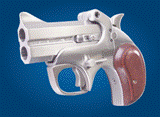 Developed in Texas State on Terra, these tiny pistols are capable of firing.357/.38 caliber, 9MM, or .410 gge shotgun rounds. Other version are also available. Many RDFer's carry them as backup weapons, though REF's can't in the field due to unreliability of ammo replacement. |  Developed by GLOCK of Terra on the original G26/27 manufacturing equipment (after retooling), these tiny laser pistols are fair examples of the type of primary weap of most investigators, and back up weaps of many police officers. This particular example has an expanded magazine. | ||||||||||||||||||||||||||||||||||||||||||||||||||
| Purpose: Generally last ditch self-defense. Weight: 1/2 lb. Damage: Varies by ammo; P-662 versions will work. Attacks per melee: 3 attacks per melee max; With practice, reloading BOTH barrels take one ATM. Effective Range: Varies by ammo. | Cost and Availability: 300-400credit; Special order item taking 4 to 6 weeks in the Sol System, 2 to 4 months in the Milky Way Galaxy (includes Local Group), and up to a year beyond that. Most systems manufacture a clone under license (effectively 4 to 6 weeks). Black Market: About the same. | Purpose: Generally last ditch self-defense. Weight: 1/4 lb. Damage: 2D8 per blast. Attacks per melee: Per user. Effective Range: 200 feet. Capacity: 20 shots normal; 25 with the extended clip. A 200 shot oversized clip is also available (-2 strike). Cost and Availability: 300-400credit; Some systems manufacture a clone under license. | Black Market: About the same. Bonuses: The M-27's safety is a sub-trigger inside the trigger assembly; By squeezing the safety off, the weapon will partially energize creating a laser pointer (+1 strike, with effectively no capacity limit). It can also be used as a laser pointer (for meetings) or designator (for missiles, +3 to pilot/gunners strike). The standard mag give a +15% concealment (very compact). | ||||||||||||||||||||||||||||||||||||||||||||||||
This Brother-specific weapon actually fire a RIFLE round. The revolver is opened 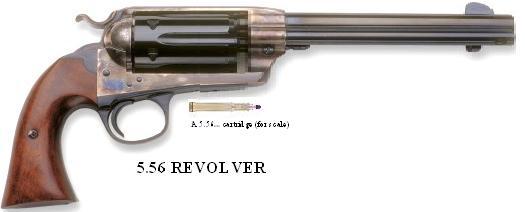 with a Loading Gate, rather than more traditional side-opening, and automatically attempts to eject spent shell casings when the gate is open. The cylinder can be removed quickly as well, allowing it to be switched out in combat. with a Loading Gate, rather than more traditional side-opening, and automatically attempts to eject spent shell casings when the gate is open. The cylinder can be removed quickly as well, allowing it to be switched out in combat.The Brotherhood used the pistol extensively, even manufacturing possibly millions of units specifically for sale to others. The chamber and barrel were reinforced to be compatible with Plasma-662. By current standards, the Brotherhood 5.56 is archaic and (worse) outdated, but it's still carried as a primary defensive weap in some outlier areas, but mostly by the Brotherhood itself as a ceremonial weap (Squire and above). | 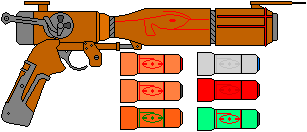 An archaic piece of Garudan technology, a spellcaster (or more commonly "caster/caster gun") fires a pre-made spells loaded into cartridges ("shells") with a spell embedded in it, and therefore be used by people with no magical affinity whatsoever. There are 20 different types of Caster shells, with varying degrees of efficacy and potency. The three most dangerous are #4, #9, and #13. The Caster gun can also fire a mundane round, the #21, that simply hits the target with the intent of killing them by blunt force trauma, and the #22 shell that creates a parachute flare (variants are a white, b red, and c green- ie, a #22c is a green flare). | ||||||||||||||||||||||||||||||||||||||||||||||||||
| Purpose: Defense. MD: 1D4 Rate of Fire: Per users attacks per melee. Range: 1,300 feet Capacity: 6 rounds per cylinder; Cylinders can be reloaded while in place, or switched out by swinging the gate open further than it opens automatically. Weight: 1/4 lb. Payload: 6 rounds. Cost and Availability: Routinely available. Non-BOS users and makers are pretty common. Magazine and Ammo Availability: 20credit for a case of 1,000 round; Commonly available. Can also fire standard cordite-based 5.56MM and .223 caliber rounds, but at much lower damage and range. | Purpose: Defense. Damage/Effect: 01: Unknown; Unknown. 02: Unknown; Unknown. 03: Red energy blast; Very common. 04: Creates a singularity that envelopes the target (like a miniature black hole); Very rare. 05: Creates a whirlwind that evaporates into water after impact with the target; Moderately common. Questionably desirable by most users. 06: Unknown; Unknown. 07: Unknown; Unknown. 08: Unknown; Unknown. 09: Creates a crimson energy blast, after impact it sends target flying by strong concussive force; Very common. 10: Fires a red and black energy blast; Very common. 11: Fires a reddish energy blast that explodes upon impact; Very common. 12: "Hellstormer": Fires an electrical energy blast that stuns all targets (living or machine); Looks like a lightning bolt when fired; Common. | 13: Fires a yellow energy blast that kills the target. When used against another blast, it spreads into a shrapnel effect; Moderately common. 14: Unknown; Unknown. 15: Unknown; Unknown. 16: Unknown; Unknown. 17: Unknown; Unknown. 18: Unknown; Unknown. 19: Unknown; Unknown. 20: Unknown; Unknown. 21: Mundane round that simply hits and kills the target; Very common. 22: Parachute flare (see discussion, above); Common. Rate of Fire: 2 attacks per melee. Range: About 1,000 feet Weight: 2.5 lbs. Payload: 1 shell. Cost and Availability: The casters themselves are moderately common; See shells list for their commonality. Ammo Availability: Between 500credit for common shells and tens of thousands for rare ones; Commonly available. | |||||||||||||||||||||||||||||||||||||||||||||||||
A rarely used option for the 5.56 Pistol is a stock. Originally designed with a screw tightening system, the Brotherhood used a spring loaded latch.  There are few reports of them being used, except by Paladins hunting certain game (fire geckos in particular), and the BOS has no report of ever having more than 10 in inventory at any given time. There are few reports of them being used, except by Paladins hunting certain game (fire geckos in particular), and the BOS has no report of ever having more than 10 in inventory at any given time.Effect: -1 apm for the first melee, +3 strike. | |||||||||||||||||||||||||||||||||||||||||||||||||||
| Long arms (rifles) are generally used by those who specifically intend in the ordinary course of business to engage in combat; This normally means infantry personnel, but not specifically to exclusion. | |||||||||||||||||||||||||||||||||||||||||||||||||||
| The M-93 "Crna Strela" (Serbian, "Black Arrow") was developed by Serbian terrorists during the Balkan Massacres of the 1990's from the NaZI German Mauser Rifle. It is a bolt action, detachable box-magazine fed rifle, based on the much older (and famous) Mauser rifle, stretched out accordingly for the bigger cartridge. The receiver features a scope rail and a back-up rear open sight; The folding front sight is mounted on the barrel. Heavy free-floated fluted barrel is fitted with large and effective muzzle brake, which decreases the felt recoil down to acceptable level, and the rifle is fitted with butt stock, which is adjusted for length of pull, and with the integral folding bipods at the front of the receiver. The folding carrying handle is mounted above the bipods. The standard scope is a fixed power 8 by 32. Ammunition is fed from a detachable box magazine. The safety is located within the trigger guard, behind the trigger, and blocks the trigger when engaged. The primary purpose of this rifle is long range engagement, often of hardly visible targets. Currently many non-, trans-, and extra-national and nationalist groups use this weap (amongst others) to wage various terror campaigns, including oddly Tiresian Malcontents who are believed to have come to appreciate it's strengths by coming under fire by them during the Second Terran Reconstruction. Syhith forces are suspected to be operating them, and T'sentraedi Malcontents are not only known to use them but even manufacture them for their micronized forces.
Name: M-93 (said "Model Niner Three Black Arrow Sniper Rifle"). |
The FN P90 submachine gun (SMG) was developed in the Post Global Civil War period as a defensive weapon for second echelon troops- Vehicle, tank, and artillery crews, etc. Patrol personnel, especially the Boarding and Initial Safety Inspection crews, have also adopted them for boarding's, due to their relative compactness and that standard pistols and SMGs chambered for pistol rounds were proved ineffective against some enemies. It was in fact, that very reason, enemy soldiers wearing body armor, that FN Herstal developed this gun around a new round- The 5.7 by 28MM SS190. The enhanced penetration of the 5.7 by 28MM SS190 was accomplished as it was, essentially, a scaled down 5.56MM NATO round, which forced the pointed, steel core bullet out the bullet at INCREDIBLE velocity, thus making it capable of defeating most types of body armor. The P90 is a blowback operated, selective fire weapon. It is fed from 50-rounds box magazines. The magazine is located above the barrel, with the cartridges being aligned at 90 degrees to the barrel axis; A built-in ramp that rotates cartridge to the proper position of inserting into the firing chamber. The P90 controls are completely ambidextrous, with charging handles located at the both sides of the weapon; The safety/fire mode selector is below the trigger; The ejection port is DOWNWarD, preventing expended shells from hitting the owner (though a shell catcher is also available). P90 has a HIGHLY inventive stock and gunstyle configuration and features built-in multi-optic sights (see Features), as well as a set of the backup open sights. The weapons can also be fitted with a silencer. P90 is currently in use by various police departments and SWATs, Spaceway Patrol And Enforcement Services units, UGC Marine Corps Embassy Security Detachments, various private security agencies, prison guards, and private citzens all over. They can also be fitted with a breech-aligned bipod, extension barrel, and under-barrel attachments, including the M-21 Plasma Launcher, M-203 Grenade Launcher, MT-261 Vibro Bayonet/Knife, etc. Name: P-90 (said "Papa Niner Zero") "Enforcer" Security Force Gun; AKA the "Pupgun" (for it's bull-pup inspired configuration) and "Security Blanket" (due to it's rising popularity with security forces). | ||||||||||||||||||||||||||||||||||||||||||||||||||
| Purpose: Anti-Personnel Sniper Rifle Caliber:.50 BMG; Also available in 12.7 by 108MM. Propellant: Plasma Operation: Manual Rotating Bolt Action Weight: 25 lb (16 kg) Overall Length: 5 feet, 5 inches (1670 mm) Barrel Length: 3 feet 3 inches (1000 mm) Feed Mechanism: Manual bolt MD: 3D6 times 10. Rate of Fire: Single shot only; Bolt action. Range: 1,500 feet Payload: Variable capacity magazines; Available capacities include 5, 10, 25, and even 500 (500 is only available in a drum clip type). | Weapon Cost and Availability: 10,000credit each; Routinely available. Can also be ordered from the factory. Ammo Cost and Availability: A case of 10 costs about 25credit each, and is available at shops all over the place or directly from the factory. Black Market Cost and Availability: 1,000 to 25,000credit each; Fairly common availability. Black Market Ammo Cost and Availability: A case of 10 costs between 25 and 100credit each; Availability varies, as only criminals with WILDLY criminal records would bother with the black market for this particular product. | Purpose: Second Echelon Self-Defense Rifle Propellant: Plasma Caliber: 5.7 by 28MM SRS229 Operation: Semi-automatic Weight: lbs empty (2.54 kg); lbs loaded with magazine. Overall Length: 1 foot, 7.5 inches (500 mm) Barrel Length: 10 inches (263 mm) Feed Mechanism: A specially-designed detachable box mag. Only available in the 50 round variant. MD: 5D6 Rate of Fire: Standard. Range: 656 feet (200 meters). | Payload: 50 rounds Cost and Availability: 1,500credit each. Availability: Routinely available. Black Market Cost and Availability: 200 to 3,000credit each; Routinely available. Soldiers SOMETIMES buy them on the grey market from suppliers for their own use. Ammo Cost and Availability: A case of 100 costs about 25credit each, and is available at shops all over the place or directly from the factory. Black Market Ammo Cost and Availability: Not applicable; The black market doesn't HAVE a market for this product. | ||||||||||||||||||||||||||||||||||||||||||||||||
| Features: Reflects features that have been installed. | Features: Reflects features that have been installed. | ||||||||||||||||||||||||||||||||||||||||||||||||||
| | |||||||||||||||||||||||||||||||||||||||||||||||||||
 A "FONTAIN HEAVY" Named for one Jer FONTAIN of the merc group "The Anarchists" (loosely affiliated with the Brotherhood Of Steel, though they never affiliated themselves with the RDF, ASC, or REF), who purportedly made the First ones; It's really nothing more than a Browning A5 with a cut-down stock, banded to an M-16. Though this weapon failed to catch on in and of itself outside The Anarchists (and, to a lesser extend, with the BOS), it was the inspiration for the M-18 and -21 currently in mainstream service. The Fontain was VERY popular with police forces for many years, especially during the highly restrictive Invid Occupation and REF Reconstruction periods, but fell out of favor after the New York Uprising of 2101. The M-16 is fed with a detachable box, but the A5 is fed by a fixed tube magazine. |  The old Robotech Masters Assault Rifle, also known as the "281," is still HIGHLY popular, especially by settlers outside of the protections of city limits. First developed in 1562 AD, the "281" is, technically, a particle beam rifle, and is named for its designer and date of acceptance (281, 112 on the Imperial Calendar). Rugged and reliable, this weapon was a match for any weapon ever fielded. Unlike most energy weapons, this rifle did not use a detachable energy magazine, but instead the entire weapon was one large battery pack, and was recharged in its storage rack. This battery had a very large capacity, being extremely advanced, but the REF has long since Mastered the technology and developed a second, detachable emergency back-up e-clip for the weapon. The "281" is capable of fully automatic fire, and numerous variants have appeared, including one with a beam defocusser mounted to the barrel, which allows it to be used to scramble the electronics of its target, occasionally allowing an infantryman to disable (though often only temporarily) unshielded and unsophisticated Mecha. There is also versions with stocks and versions with folding stocks for more compact use. The "281" was a prime, though not only, influence on the Gallant H-90. | ||||||||||||||||||||||||||||||||||||||||||||||||||
| Purpose: Assault/Defense. Damage: 5.56MM: 4D6 SD. 12 gge shotgun shell: 4D6 SD Rate of Fire: Special: The M-16 can be single- or 3-round burst fire; The shotgun is single fire only, BUT the two weapons can be fired together (effectively double the attacks per melee). Note that the shotgun can ONLY be single fire, regardless whether the M-16 is single or burst fire. Range: 5.56MM: 1,200 feet. 12 gge shotgun shell: 100 feet before damage halves, then halves AGAIN at 300 feet; Totally ineffective beyond 500 feet. | Payload: 5.56MM: 5, 10, 25, and 50 round clips standard; A drum clip of 500 rounds IS available, but very rare. 12 gge shotgun shell: 10 rounds. A mag extension is available to accommodate an additional 2 rounds, but is expensive (200credit) and not very popular. Bonuses/Penalties: Automatic HF of 10. Weight: 10.25 lbs. fully loaded. Weapon Cost and Availability: 1500credit; Pretty rare. Ammo Cost and Availability: A box of 100 5.56MM rounds costs about 15credit; A box of 50 12 gge shells costs about 15credit. | Purpose: Assault/Defense Damage: 5D6 SD or MD Range: 500 feet. Payload: Primary Built-In Battery: 500 blasts (nominal); Secondary E-Clip: 200 blasts from e-clip or unlimited from e-cable; Tertiary E-Plate: An E-plate mounted in the grip gave the rifle an unlimited payload. | Weight: 20 lbs. Weapons Cost and Availability: 5,000credit; Good availability. E-Clip cost and Availability: 200credit; Excellent availability. Black Market Cost and Availability: Between 500 and 8,000credit; Fair availability. E-Clips run around 200credit, and have excellent availability. | ||||||||||||||||||||||||||||||||||||||||||||||||
| | |||||||||||||||||||||||||||||||||||||||||||||||||||
 The UGC's standard laser rifle, the M-18 is actually a fixed-mode version of the H-90. The weapon depicted here has the optional M-21 Plasma Launcher accessory attachment, though M-36 "Badger" Sub-Machinegun is possible as well. |  Though largely obsolete for REF front-line troops, the M-35 is still in service with many RDF's, and is common amongst settlers, County Militias, and City Guards. The only significant upgrade is that the grenade launcher, M-37, now is a single-shot mini-missile launcher, the M-39b. The 4.45MM has two types of ammo, the Alpha type used mostly for training, and Bravo type used in combat. | ||||||||||||||||||||||||||||||||||||||||||||||||||
| Purpose: Assault Rifle Weight: 9 lbs. Damage: 2 settings, 4D6 SD or MD. Rate Of Fire: Standard Effective Range: 2,100 feet Payload: 3 shots per E-Clip, 80 per E-Canister (a Tiresian invention). | Cost and Availability: 5,000credit each; Always available. Black Market Cost and Availability: 500 to 50,000credit each, depending on the buyer and the seller; Routinely available. Soldiers are known to buy them privately on the grey market from suppliers, then sell them to "friends with needs." | Purpose: Defense Damage: Assault Rifle: The rifle has two types of ammo available- Alpha rounds do 4D6 SD, Bravo rounds do 1D6 MD. Grenade Launcher: Per missile. Range: Assault Rifle: 1,150 feet; Grenade Launcher: Per mini-missile. Payload: Assault Rifle: 60, 90, or 120-round clips are available. Grenade Launcher: Single shot. | Weight: 20 lbs. Weapon Cost and Availability: 20,000credit; Always available (many REF troops privately own one). Ammo Cost and Availability: 2,000credit per case of 200; Always available. Ammo Clip Cost and Availability: 200credit; Always available. Black Market Cost and Availability: Between 200-200,000credit; Always available (this is one of the few non-Robotech Master weapons found in Tiresian Malcont possession). Ammo costs about 2,000credit per case of 200, and clips 200credit, and are likewise always available. | ||||||||||||||||||||||||||||||||||||||||||||||||
| | |||||||||||||||||||||||||||||||||||||||||||||||||||
The Badger has been in service for many many years; It is especially popular with REF Special Forces. Fires the 9MM round. It can also be mounted under the barrel of some long guns  (rifles), turning them into so called "lights" (where a lighter weapon is mounted to a heavier one, the opposite of a heavy). The base unit is short enough that it can be carried in a fairly normal holster, though it best carried in this condition with a short magazine (a 15 round or smaller mag). The long barrel can be attached in 1 melee action. The stock can also be detached (-5 strike in automatic, -1 strike in semi-auto, 1 melee action to attach). (rifles), turning them into so called "lights" (where a lighter weapon is mounted to a heavier one, the opposite of a heavy). The base unit is short enough that it can be carried in a fairly normal holster, though it best carried in this condition with a short magazine (a 15 round or smaller mag). The long barrel can be attached in 1 melee action. The stock can also be detached (-5 strike in automatic, -1 strike in semi-auto, 1 melee action to attach). |  A fairly common infantry rifle used by civil defense units and police departments. Also popular with varmint and bounty hunters, bail/lien enforcers, settlers, etc. This weapon is not as electricity dependent as other UGC weapons. | ||||||||||||||||||||||||||||||||||||||||||||||||||
| Purpose: Assault Damage: SD: 2D6; MD: 1D4 Range: 600 feet. Payload: 30, 60, and 90-round clips are available. Weight: 10 lbs. Weapon Cost and Availability: 20,000credit; Always available (many REF troops privately own one). Ammo Cost and Availability: 2,000credit per case of 200; Always available. | Ammo Clip Cost and Availability: 200credit; Always available. Black Market Cost and Availability: Between 200-200,000credit; Always available (this is one of the few non-Robotech Master weapons found in Tiresian Malcont possession). Ammo: 2,000credit per case of 200, and clips 200credit, and are likewise always available. | Purpose: Assault Rifle Weight: 9 lbs. MD: 4D6 per blast. Rate Of Fire: Standard Effective Range: 2,000 feet. Payload: 800 shots per clip. | NOTE: The clip actually parallels the barrel on the top side. Cost and Availability: 5,000credit each; Always available. Black Market Cost and Availability: 500 to 50,000 each, depending on the buyer and the seller; Routinely available. | ||||||||||||||||||||||||||||||||||||||||||||||||
| | |||||||||||||||||||||||||||||||||||||||||||||||||||
Conceptually, this is actually just a re-engineered Thompson Sub-Machinegun with a SPAS-12 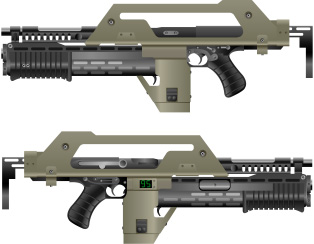 Shotgun mounted on it, the shotgun rounds converted to mini-grenades; This superposed ("over-under") weapons system was in service throughout the length of the "official" RDF and through the earlier REF service. With the conversion to P-662, it could have stayed in REF service but for the advent of the H-90, which relegated the ARS to tertiary ditties. They can still be found in the hands of many local RDF's as well as police departments, militias, and settlers. Shotgun mounted on it, the shotgun rounds converted to mini-grenades; This superposed ("over-under") weapons system was in service throughout the length of the "official" RDF and through the earlier REF service. With the conversion to P-662, it could have stayed in REF service but for the advent of the H-90, which relegated the ARS to tertiary ditties. They can still be found in the hands of many local RDF's as well as police departments, militias, and settlers. | The AKLU-85 (Kalashnikov Automatic Laser Carbine Model Of 2185) was developed by the Russian States (post-Invid EBSIS) 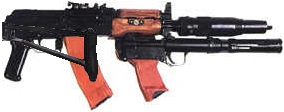 mainly to maintain control over their people; Overworked and underpaid ("unpaid, unfed, and unhapppy"), the threat of rebellion hung over the heads of the Leadership like an axe ready to drop. mainly to maintain control over their people; Overworked and underpaid ("unpaid, unfed, and unhapppy"), the threat of rebellion hung over the heads of the Leadership like an axe ready to drop.Unable to reverse the situation, the Russian States were eventually overthrown. However, before that happened the AKLU-85 had already been exported to several client states, including the T'sentraedi Militia States and other malcontent groups off-world. Worse, terrorist groups (such as C.O.B.R.A.!) have been manufacturing them for their own use and for sale to others. Depicted is an AKLU-85 with a GSN-21 Silenced Grenade Launcher/Sub-Machingun, making it both a Heavy and a Light. This is not commonly seen outside of the Russian States. | ||||||||||||||||||||||||||||||||||||||||||||||||||
| Purpose: Assault Purpose: Assault/Defense. MD: Rifle: 1D6. Grenade Launcher: 2D6. Rate of Fire: Special: The M-16 can be single- or 5-round burst fire; The shotgun is single fire only, BUT the two weapons can be fired together (effectively double the attacks per melee). Note that the shotgun can ONLY be single fire, regardless whether the M-16 is single or burst fire. | Range: Rifle: 800 feet. Grenade: 200 feet. Payload: Rifle: 50 round mags standard (larger mags interfere with the grenade launcher). Grenade Launcher: 10 rounds. Bonuses/Penalties: Automatic HF of 10. Weight: 13 lbs. fully loaded. Weapon Cost and Availability: 1,800credit; Pretty rare. Ammo Cost and Availability: A box of 100.45-20 rounds costs about 200credit; A box of 50 grenades costs about 15credit. | Purpose: Assault/Defense. MD: 2D6. Rate of Fire: Per user. Range: 800 feet. Payload: 500 round mags standard. Weight: 8 lbs. | Weapon Cost and Availability: 600credit; Obscenely common. E-Clip Cost and Availability: 200credit; Excellent availability. Black Market Cost and Availability: Between 500 and 8,000credit; Fair availability. E-Clips run around 200credit, and have excellent availability. | ||||||||||||||||||||||||||||||||||||||||||||||||
| Support weapons are used by militry personnel to discourage an enemy from using their own weaps, without carrying the bulk involved in heavy weaps. They provide immediate light fire support, and as such generally only last a short while and give limited support- which is far better than nothing, since heavy weaps often can not be moved with infantry effectively (such as the M-2 and M-550d). | |||||||||||||||||||||||||||||||||||||||||||||||||||
| | | ||||||||||||||||||||||||||||||||||||||||||||||||||
 An accessory for Assault rifles of any type, mounted by simple swivel screws with quick-tightening wing nuts. Does not interfere with MT-261. This weapon was more influenced by the T'luaza Milldiem 281 Model Assault Rifle than the H-90 was, as the H-90 is an actual laser; The M-21 is more of the particle beam of the "281". There has been noted a similarity between the M-18/M-21 combination and the FONTAIN Heavy; This observation is inappropriate, however, as ALL Heavies look a little bit alike. |  The Marine needed a heavier energy weapon that could be handled by one man to support a squad. The M-23 Lasooka is the result. The notch is set on the marine's shoulder. S/He then can fire a blast heavy enough that it will effect all but the heaviest Mecha, forcing them to re-think their plans. It's also used to bust open bunkers. The Lasooka is a short-range weap, but HIGHLY effect at that range. | ||||||||||||||||||||||||||||||||||||||||||||||||||
| Purpose: Heavy Assault Weight: 10 lbs (plus the 9 lbs of the M-18, for a total of 19 lbs.). MD: 5D6 per blast. Rate Of Fire: Standard Effective Range: 2,000 feet Payload: 10 blasts per E-Canister (uses a separate E-Canister). | Cost and Availability: 6,000credit for a launcher and another 2,000credit for the specialized E-Canister needed to use the weap; By special request (4 to 6 weeks for delivery). Black Market Cost and Availability: 600 to 60,000credit, depending on the buyer and seller; Rarely available. Soldiers know better than to sell these. | Purpose: Heavy Assault Weight: 25 lbs. MD: 10D4 per blast. Rate Of Fire: Once per melee. Effective Range: 600 feet. | Payload: 5 blasts per E-Canister. Cost and Availability: 60,000credit each. Black Market Cost and Availability: 6,000 to 6millioncredit, depending on the buyer and seller; Rarely available. | ||||||||||||||||||||||||||||||||||||||||||||||||
| Heavy weapons are generally too heavy to effectively employ with infantry on the move. They are usually used either for static (fixed) position in a defensive mode, or as vehicle-mounted weaps for offence. | |||||||||||||||||||||||||||||||||||||||||||||||||||
| | | ||||||||||||||||||||||||||||||||||||||||||||||||||
A highly popular choice; This fully automatic heavy machine gun has been around since the early 20th Century on Earth, and nearly identical ones have existed just about everywhere. In all mechanical functions, the Regult Series Battle Pods auto-cannon is so similar that some would call them identical; Only  the caliber is significantly different (and thus, the engineering IS different). The addition of Depleted Uranium rounds to the available inventory has added to the lethality of the 50's significantly. Also, during the War with the Regent, Plasma-662 propellant was developed; The charge was reduced to exactly emulate the effect of Cordite propellant, so it does NOT effect the damage. The weapon rests on a specially designed rig, allowing it to swivel and track according to the pilots wishes (though it IS a 2-handed weapon. The rig "can" be modified to accept other heavy weapons, but requires a competent armorer who has the skill jury-rig (or similar skill). the caliber is significantly different (and thus, the engineering IS different). The addition of Depleted Uranium rounds to the available inventory has added to the lethality of the 50's significantly. Also, during the War with the Regent, Plasma-662 propellant was developed; The charge was reduced to exactly emulate the effect of Cordite propellant, so it does NOT effect the damage. The weapon rests on a specially designed rig, allowing it to swivel and track according to the pilots wishes (though it IS a 2-handed weapon. The rig "can" be modified to accept other heavy weapons, but requires a competent armorer who has the skill jury-rig (or similar skill). | 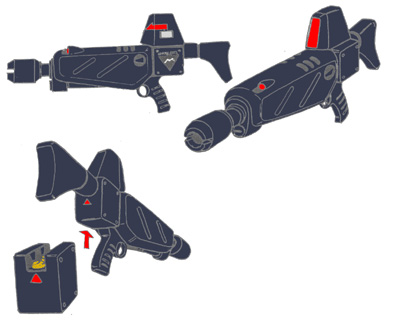 A large energy rifle designed for the Cyclone series power armors; It can be used by those not in power armor like a rifle, but is heavy and awkWard, and imposes a penalty of -3 to strike (unless the barrel is propped up on something). The EP-37 comes complete with built in telescopic sight with integral light amplifying (starlight) scope. This was the weap preferred by most Power Armored troops during the Wars with the Invid, including Commander Scott BERNARD (REF Spacy). Grav-pod equipped versions have begun showing up with street gangs; Appropriate caution should be observed relative to the degree of threat- They can blow an average police car up, after all. | ||||||||||||||||||||||||||||||||||||||||||||||||||
| Purpose: Anti-Personnel/Armor Damage: Lead (Ball) shot: 7D6 Per round; Depleted Uranium rounds: 1D6 times 10 MD per round. Rate of Fire: Single Fire: 1 Shot per user's attacks per melee. Auto Fire: 5 round bursts per pilots attacks per melee. (Can actually fire up to 5,000 times per melee, but soldiers are trained to fire in 5 round bursts.) Range: 7,000 feet Payload: Up to 500 rounds can be carried easily. Weight: 50 lbs | Weapon Cost and Availability: 5,000credit; Occasionally available. Highly sought after, and made by a wide number of black marketeers. Ammo Cost and Availability: Ball rounds: 800 to 1,000credit for a box of 50; Routinely available; DU rounds: Up to 100 thousandcredit for a box of 50; Rare. Highly sought after. Bonuses/Penalties: Can only be fired in 5 round bursts, to a maximum of 200 rounds per minute; Though the gun can EASILY cycle faster than that, it overheats the barrel, causing it to distort and bullets to jam inside of the barrel, causing a pileup in the barrel; This leads to barrel breach, and 1D6 MD to the gunner and anyone around him (regardless the ammo type). | Purpose: Assault MD: 1D4 times 10 per blast Rate of Fire: Aimed, burst, or wild. Range: 4,000 feet Payload: 10 shots with a standard e-clip. Weight: 14 lbs Weapon Cost and Availability: 10,000 to 15,000 each; Occasionally available (there just isn't as much of a market for these). | Cost and Availability of e-clips: 50 to 500credit each. Recharges cost about 100credit each; Occasional. Bonuses/Penalties: -3 strike without power armor. With a proper support (bipod or resting on something), this penalty is negated, but the user can not dodge as easily (-5 dodge). | ||||||||||||||||||||||||||||||||||||||||||||||||
| | | ||||||||||||||||||||||||||||||||||||||||||||||||||
Another energy weapon specifically designed for use with the Cyclone series, this weapon is essentially an 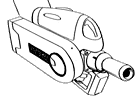 oversized pistol. It comes complete with a built-in laser targeting system that provides a bonus of +1 strike. Unfortunately, it's weight and awkWard size makes it impossible for non-power armored troops to use. oversized pistol. It comes complete with a built-in laser targeting system that provides a bonus of +1 strike. Unfortunately, it's weight and awkWard size makes it impossible for non-power armored troops to use. | 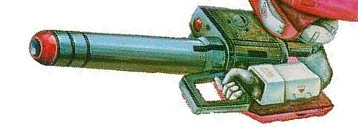 The RL-6 is standard issue with the VR-038 Lt Cyclone. The mini-missiles are carried in 6 round clips and require a full melee to reload. The weapon is essentially the modern version of the recoilless rifle, and as such can ONLY be used as a shoulder mounted weapon. Most pilots like to have a second (or Third) weapon as well. | ||||||||||||||||||||||||||||||||||||||||||||||||||
| Purpose: Assault MD: 4D6 per blast Rate of Fire: Aimed, burst, or wild. Range: 2,000 feet Payload: 30 shots with a standard e-clip. Bonuses/Penalties: -10 strike without power armor, and can even then, only be used as a 2-handed weapon. | Weight: 22 lbs. Weapon Cost and Availability: 15,000 to 22,000; Fair to occasional availability. There is a bit more of a market for this weapon than there is the EP-37. E-clip Cost and Availability: 50 to 150credit. Recharges cost about 75credit each (uses the same equipment as the EP-37); Fair availability. | Purpose: Assault Missile Type: Any mini-missile except plasma. MD and Range: Varies by type used. Range is generally around 1 mile. Rate of Fire: One at a time per pilots attacks per melee. Payload: 6 mini-missiles per clip. Reloading takes 1 full melee. Weight: 16 lbs | Weapon Cost and Availability: 100,000 new and undamaged. HIGHLY prized by those who can get them; EXTREMELY rare; Only the PB-22a is more rare. Mini-Missile Cost and Availability: 20,000 to 50,000 each; UTTERLY rare. Clip Cost and Availability: Roughly 5,000 each; Occasionally available. | ||||||||||||||||||||||||||||||||||||||||||||||||
| | | ||||||||||||||||||||||||||||||||||||||||||||||||||
Essentially a scaled down version of the T'sentraedi Nousjadeul-Ger (male power armor) shoulder cannon. Originally developed and deployed in South  America, Terra, Sol by both malcontents and the RDF for fixed-position defense by the rather simplistic expedient of simply taking the PBC's and adding various mi'cronne triggering devices and connecting the weapon to a central power supply (i.e., plugging into a 220-watt wall outlet). America, Terra, Sol by both malcontents and the RDF for fixed-position defense by the rather simplistic expedient of simply taking the PBC's and adding various mi'cronne triggering devices and connecting the weapon to a central power supply (i.e., plugging into a 220-watt wall outlet).These are very rarely purpose-built, and almost exclusively to defensive positions; They're far more likely to be used by startups, and almost to exclusion malcontent startups. A few million remain in UGC service, but these are being taken out of service as quickly as possible, replaced by L-02a's more the most part. In a decade, they should be out of service entirely. You're far more likely to see one that has been built from a Nousjadeul-Ger's PBC by its current user under field conditions, since they're usually stripped down for the few valuable parts to rebuild other weapons, with the majority of it being scrapped outright. |  This was Terra's First "front line" energy weapon; An old M-2 was refitted with an "excited focused particle beam emitter" (a crude PBC) for mining and demolition work; After testing, it was tested for LE to disable vehicles; Success there led to testing for anti-missile operation; Success there (in conjunction with radar and computer control systems) led to testing as anti-armor ssytems. It excelleled in all the above, but was not adequate for anti-aircraft and couldn't actually 'destroy' any of the above so much as disable them, though 'disabling' a missile caused them to crash or self-destruct more often than not. It's no longer in general UGC service, but is in use with many RDF's, CDF's, militias, and Mining companies. | ||||||||||||||||||||||||||||||||||||||||||||||||||
| Purpose: Assault MD: 4D10 per blast Rate of Fire: Per pilots attacks per melee. Range: 4,300 feet (1,300M). Payload: 100 blasts before the Power armor has to secure power to the weapon or overload; This is the only energy weapons that actually puts a drain on the suit. | Weight: 20 lbs Weapon Cost and Availability: 2,000 to 2,500 new and undamaged; Horribly unpopular, and rarely seen outside of the battlefield itself. Occasionally found in outlier systems in ones and twos, usually in questionable condition. E-clip Cost and Availability: Not applicable. | Purpose: Assault MD: 4D10 per blast Rate of Fire: Per pilots attacks per melee. Range: 4,300 feet (1,300M). Payload: E-Cable: Unlimited E-Mag:100 blasts. | Weight: 20 lbs Weapon Cost and Availability: 200,000 to 250,000 new and undamaged. HIGHLY prized by those who can get them; EXTREMELY rare. E-clip Cost and Availability: 500 to 2,000 each. Recharges cost roughly 50 each; Very rare. | ||||||||||||||||||||||||||||||||||||||||||||||||
| The primary differences between these two weapons is cost, flexibility, and reliability. The P-22a only works with a power cable, whereas the M-550d was designed to work from e-mags or e-cables. As such the P-22a is much cheaper to produce, but not as flexible, and is more prone to breakdowns over extended use (mainly due to the fact that the Robotech Masters repurposed a mining implement as a weapon with the most minimal retrofitting they could to save money, as T'sentraedi were "completely expendable, not even worth the money to upgrade"). | |||||||||||||||||||||||||||||||||||||||||||||||||||
A small handheld gun pod designed to be used by the Garland series Power Armor.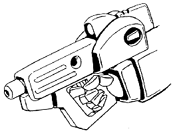 This handheld weapon is a fairly popular replacement for the EP-40 Pulse Beam Gun because of its non-reliance on protoculture energy supplies. The gun itself is difficult to find due to its limited production, but ammo can frequently be found in the ruins of old SC bases and equipment caches. This handheld weapon is a fairly popular replacement for the EP-40 Pulse Beam Gun because of its non-reliance on protoculture energy supplies. The gun itself is difficult to find due to its limited production, but ammo can frequently be found in the ruins of old SC bases and equipment caches. | 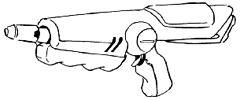 A non-protoculture, conventional ammunition version of the EP-37 Beam Cannon for the Cyclone mecha. This weapon is EXTREMELY popular with resistance fighters, as it uses the same ammunition that the GU-XX Gun Pod (used on Alpha and Beta fighters) uses, allowing the Veritechs and Cyclones to share ammo when necessary. The weapon can be used by humans without Cyclones, but is heavy and awkWard, and imposes a penalty of -3 to strike. | ||||||||||||||||||||||||||||||||||||||||||||||||||
| MD: 1D4 times 10 M.D. Rate Of Fire: Semi-automatic; equal to the pilot's combined HTH attacks. Range: 2000 ft (600 m) | Payload: 12 rounds per magazine. Magazines fit in the back of the gun. Inserting a spare clip requires 2 melee actions (1 to remove the clip, and 1 to replace it). | MD: 2D6 per short burst, 4D6 per long burst, or 1D6 times 10 per full melee burst. Rate Of Fire: Short or medium bursts count as one attack. The pilot may fire as many bursts as his combined HTH attacks per melee. A full melee burst takes the place of all attacks. Range: 4000 ft (1200 m) | Payload: Can fire 12 short bursts, 6 long bursts, or 3 full melee bursts per clip. Note that although the bullets used by the GU-19 and GU-XX are the same, the clips themselves are different. Therefore bullets must be unloaded from one clip and loaded into another if the two mecha are going to share ammo. | ||||||||||||||||||||||||||||||||||||||||||||||||
A unique weapon developed for the Global Military Police (GMP) during the years before the Second Robotech War, this weapon 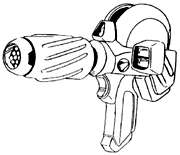 fires a woven cable net about 10 feet in diameter. The net is very strong, and breaking it requires the victim to do at least 20 MDC points of damage (total) to the net; each strand is only 1 MDC each, but many strands must be broken before the victim can be freed. It will take 4D6 melees for a person to untangle himself or herself from the net. fires a woven cable net about 10 feet in diameter. The net is very strong, and breaking it requires the victim to do at least 20 MDC points of damage (total) to the net; each strand is only 1 MDC each, but many strands must be broken before the victim can be freed. It will take 4D6 melees for a person to untangle himself or herself from the net.The N-1 Net Gun was originally designed to help GMP agents capture fugitives and suspects without a great risk of harming them (or their hostages). Due to this fact, this weapon is seldom used by terran resistance, as they seldom desire to actually capture an Invid. Instead, it is more commonly used by Frags and other Invid sympathizers to capture resistance fighters and slaves for the Invid. Only Tom McCAIN used them to any success against the Invid. |  A rather powerful and dangerous weapon developed for the Garland cyclones shortly before the arrival of the Robotech Masters. This weapon is fairly rare and well sought after for it's destructive potential. The GU-21 fires 45MM fin- stabilized grenades, and can use several different types of grenades. The weapon uses a unique ammo clip that can carry up to 3 different types of ammo, and can switch between those ammo types by flipping a switch on the back of the rifle. The GU-21 ca use High Explosive Anti-Tank (HEAT), Fragmentation (FRAG), Smoke or Gas grenades. The GU-21 can also be equipped with an external N-2 net launcher, which launches a net similar to the N-1 net gun. The N-2 Net Launcher can be attached as well. | ||||||||||||||||||||||||||||||||||||||||||||||||||
| Primary Purpose: Capture MD: None; see above. Rate Of Fire: Single shot weapon. Range: 100 feet. | Payload: One shot per net canister. Replacing a canister with a spare takes 2 melee actions (1 to detach the old canister, and 1 to put a new one on). Reloading a canister after it has been used requires 2D6 times 10 minutes. | MD: HEAT: 2D4 times 10 M.D. FRAG: 1D6 times 10 M.D. SMOKE/GAS: No Damage. The smoke grenades will block sight and infrared sensors, and the gas grenades may be loaded with drugs such as tear gas or sleeping gas. Rate Of Fire: Single Shots only. Number of shots per round is equal to pilot's combined HTH attacks. | Range: 3,000 ft (900 m). Payload: Each clip contains up to 30 grenades, and the 30 grenades carried can be subdivided into groups of 10 of different types. Switching types of grenades (by changing the switch at the end of the gun) takes 1 melee action. Cost And Availability: 10,000 each; Very rare. | ||||||||||||||||||||||||||||||||||||||||||||||||
| The Gallant H-90 and 1000 and the T-21 are simultaneously pistols and rifles (but not sub-machineguns, carbines, or PDW's). As such, they are listed separately. | |||||||||||||||||||||||||||||||||||||||||||||||||||
| The T-21 Multi-Phase Laser Energy Weapon was to be the successor to the H-1000 as the standard sidearm of the REF. A verastile weapon, it had an energy sword mode (which the H-90 didn't have), a stun, SD and MD setting for the pistol mode, and an MD Assault Rifle. The weapon was to include a detachable scope (not required for use) for both pistol AND rifle mode. Unlike the H-90, the T-21 can utilize E-Cables. After over 80 years of work, the T-21 project was finally cancelled due to cost overruns in development and manufacturing; While the system does work, it had become too complicated and too much money had been invested to continue development. Around 100,000 units were manufactured during that time, with no more than 5,000 being identical due to revisions during that time period. Off brand clones are seen from time to time, though typically with the sword mode removed to stabilize the pistol mode (the most common problem in development). Cost and Availability: 5,000credit each; Always available. Black Market Cost and Availability: 200 to 25,000credit each; Routinely available. Soldiers SOMETIMES buy them on the grey market from suppliers for their own use. | |||||||||||||||||||||||||||||||||||||||||||||||||||
 Generally the least popular mode, the Sword Mode is used more for cutting set materials, like a machete or for battering through doors, walls, and etc. | Purpose: Defense Operation: Standard Energy. Weight: 1/2 pound. Overall Length: 3 feet. Blade Length: 2 feet 8 inches; All energy. MD: Slash: 2D6 MD; | Punch: 3D6 MD; Power Punch: 6D6 MD Attack Per Melee: Per pilot. Range: Within reach. Payload: Not applicable. Bonuses/Penalties: +2 parry in hand to hand combat, +5 strike. | |||||||||||||||||||||||||||||||||||||||||||||||||
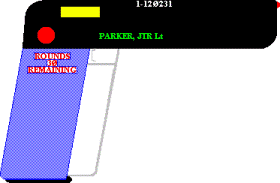 Generally the most popular mode, the pistol gives quick firepower without heavy encumberment. | Purpose: Defense Operation: Standard Energy. Weight: 1.5 pounds. Overall Length: 8 inches. Barrel Length: 1/2 inch.MD: Three modes: Stun (60% chance of stunning anyone not wearing
| environmentally sealed body armor, not effective in EBA), 4D6 SD, or 1D6 MD per blast. Rate of Fire: Standard. Range: SD/Stun: 200 ft; MD: 500 ft. Payload: Stun/SD: 1,000 blasts per e-clip, MD: 20 blasts per e-clip. Weight: 1.5 pounds. | |||||||||||||||||||||||||||||||||||||||||||||||||

| Purpose: Assault Operation: Standard Energy. Weight: 7 pounds. Overall Length: 3 feet. Barrel Length: 4.5 inches. | MD: 4D6 MD per blast. Rate of Fire: Standard; Aimed, burst, or wild. Range: 1,400 ft. Payload: 30 blasts per e-clip. Weight: 7 pounds. | |||||||||||||||||||||||||||||||||||||||||||||||||
The H-90 is the standard sidearm of the REF A versatile weapon, it has an SDC and 02 MDC settings, one in pistol mode and one in rifle mode. Rifle mode also includes a detachable scope (not required for use as a rifle). Note that the H-90 can NOT utilize E-Cables. | Purpose: Assault/Defense Damage: Pistol mode- SD: 4D6, MD: 1D6 per blast. Rifle mode: 4D6 MD per blast. Rate of Fire: Aimed, burst, or wild. Range: Pistol mode- 500 feet Rifle mode: 1,400 ft. Payload: Pistol mode- SD: 1,000 blasts per e-clip, MD: 20 blasts per e-clip. Rifle mode: 30 blasts per e-clip. Weight: Pistol mode- 1.5 pounds. Rifle mode- 7 pounds. Clips weigh 1/10 of a pound for pistol, and 1/2 pound for rifle. | Weapons Cost and Availability: Pistol- About 500 to 700credit each. Rifle Accessories- Stock is about 300 to 500credit, barrels run 200 to 250credit, and scopes run about 1,000credit each. Spare pistol clips are 50 to 100credit and rifle clips are 150 to 200credit each; E-Clips must be refilled, as they run on Protoculture, but when available run 75 to 100credit. Availability: Pistol- Common; Rifle Accessories- Stocks and barrels are common; Scopes and pistol clips are fairly available; Rifle clips are occasionally available. | |||||||||||||||||||||||||||||||||||||||||||||||||
The Gallant H-1000 Multi-Weapon System First began production in 2038 shortly before the beginning of the Third Invid War. The Gallant H-1000 was the First weapon system designed by Tiresian Weapons Research (T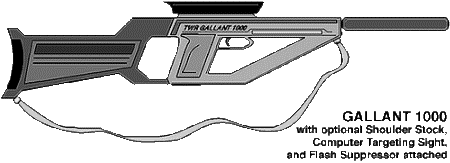 WR), a new company recently started on Tirol by several ex-REF weapons researchers who retired from the service and started their own production company. Despite accusations of favoritism from several rival production firms (most notably the Kabarran National Weapons Factory), the Gallant H-1000 proved to be an excellent weapon and quickly became the standard sidearm for the REF, replacing the aging Gallant H-90 system. WR), a new company recently started on Tirol by several ex-REF weapons researchers who retired from the service and started their own production company. Despite accusations of favoritism from several rival production firms (most notably the Kabarran National Weapons Factory), the Gallant H-1000 proved to be an excellent weapon and quickly became the standard sidearm for the REF, replacing the aging Gallant H-90 system.The Gallant H-1000 is an extremely durable weapon, requiring minimal maintenance and functioning well in any type of environment. The most notable feature of the system remains its versatility; being able to vary power levels with the flick of a switch. The Gallant H-1000 has 4 weapon settings, with various ranges and damage for each setting. All four settings can be used without the additional rifle stock (an improvement over the original H-90), although using setting 4 without the stock will exhaust the energy cell in only four shots. The Gallant itself is shaped somewhat like the original, with a complete circular housing instead of the traditional handle design. However, the top of the gun nozzle is higher and completely flat to make the gun easier to aim. The Gallant H-1000 comes with several detachable options, including a electronic sight with computer targeting interface, a flash suppressor, and a shoulder stock which can also hold additional e-clips. Like the older Gallant H-90, the Gallant H-1000 can be used as a pistol, submachine gun, or a rifle depending on what options are attached. The success of Gallant H-1000 allowed TWR to land several lucrative contracts with the Robotech Expeditionary Force, including the design of the energy weapon systems on the new VAF-8 and VAF-9 veritech fighters. The Gallant H-1000 remained the standard sidearm of the REF until 2055. Although somewhat rare compared to the Gallant H-90, the Gallant H-1000 can still be found often on Earth, a legacy to the violence of the Third Invid War. | 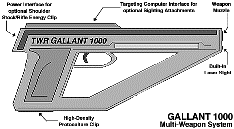 Weight: 2.5 lbs (1.1 kg) without stock, 6.0 lbs (2.7 kg) with stock. Weight: 2.5 lbs (1.1 kg) without stock, 6.0 lbs (2.7 kg) with stock.Damage: By Setting: Setting 1: 5D6 S.D. per shot. Setting 2: 1D6 M.D. per shot. Setting 3: 3D6 M.D. per shot. Setting 4: 5D6 M.D. per shot. Range: By Setting: Setting 1: 800 ft (244 m). Setting 2: 1200 ft (366 m). Setting 3: 1600 ft (488 m). Setting 4: 2000 ft (610 m). Rate Of Fire: Settings 1 and 2 can be fired as aimed, burst, or wild shots (see modern weapon proficiencies, Sentinels page 47). Settings 3 and 4 are automatically limited to semi-automatic shots (equal to the character's combined number of attacks) to prevent overheating of the firing mechanism. Payload: By Setting: Setting 1: The SDC laser draws so little power that it is effectively unlimited. (1500 shots estimate). Setting 2: 40 shots, or 120 with Rifle Stock. Setting 3: 20 shots, or 60 with Rifle Stock. (1 setting 3 shot = 2 setting 2 shots) Setting 4: 4 shots, or 12 with Rifle Stock. (1 setting 4 shot = 10 setting 2 shots) Automatic Laser Targeting (+1 to strike). Optional Computer Targeting Sight provides passive IR and nightvision targeting, as well as an additional +2 to strike. NOTE: The Gallant H-1000 still uses protoculture energy. | ||||||||||||||||||||||||||||||||||||||||||||||||||
| Artillery is far too heavy either to move with infantry or be employed with infantry on the move, and are strictly for static defense or for supporting an offense. In this regard, most artillery will not be listed here, though a few systems are in fact light enough that in a dissembled configuration can be infantry transported. | |||||||||||||||||||||||||||||||||||||||||||||||||||
Sabot, Anti-Armor Sniper Rifle (APFSDS, or the "Appophis"). | |||||||||||||||||||||||||||||||||||||||||||||||||||
The typical way the weapon is used is to target the cockpit or helmet, then shooting the spot where the pilot SHOULD be. Some machines do not have the ability to shield the pilot from thermal and other sensors specifically, therefore it is, usually, very easy to determine the position of the pilot. (This is not true with UGC Mecha, and becoming less so with Police Destroids.) Developed with 15.2MM caliber, ultra-high velocity APFSDS projectiles, the system was called Steyr IWS 2000 (Infantry Weapon System 2000), and was a VERY formidable weapon. It fires 308 grains (20 gram) tungsten fleschette dart (very similar to the early round used by the Veritech Fighter GU-11). At maximum range the projectile results in serious secondary fragmentation effect behind the armor. This is how it actually kills; Not by penetrating armor outright (though it can), but by shattering the armor on the other side, causing it to spall and kill the pilot. The weapon is hyper accurate, and in the hands of a properly trained user rises ONLY 31 inches at the full effective range of 1,500 feet. The cartridge is of somewhat original design, and has plastic case with steel head and base. The projectile is concealed within the plastic sabot. The rifle itself uses rare long-recoil system, where the barrel recoils along with the bolt for significant length, at the end of which the bolt unlocks from the barrel rotates and is held back, the barrel returning to the original position to eject the spent shell casing. The bolt then also returns forWard, chambering the new round from the side-mounted magazine and locks in place. The gun also has huge muzzle brakes; These features allows for better recoil control, allowing for greater shooting time without excess discomfort, and is described as a similar to the large-caliber sporting rifle. The original design was a five round detachable box magazine located at the right side of the receiver; However, the UGC selected a version that is belt-fed. The smooth-bore barrel can be detached, so the rifle can be carried disassembled into two man-portable packs (or easily carried by a power armored trooper). The weapon is equipped with bipod and a rear leg under the butt stock. It is also equipped with 100 times telescope with the full range of sniper rifle sensors (see Features, end). This is the most powerful rifle produced, and a true "sniper" rifle well worth mentioning. The future of this design is nearly set in stone as a weapon of GREAT importance toe the UGC, especially the Marines. Other users include various Civil Defense Forces, the police anti-robot (and other) snipers, and Galactic Intelligence Service Special Response Squads (despite the relative overkill factor). An interesting aside about the Appophis is the name; It is probably the LONGEST name for any weapon currently in existence (counting only Human, T'sentraedi, and similar language, and not the unclean languages that have infected the galaxies, such as "true" Tiresian, French, Fehran, etc). The name is, in fact, SO LONG, that it is said that in itself is deadly; You'll die of old age before you finish the First verse. Name: Steyr-Mannlicher AG Armor Piercing, Fin Stabilized, Discarding Sabot, AKA "The Appophis" (from sounding out the abbreviation "APFSDS") or "The one-man artillery battalion." | |||||||||||||||||||||||||||||||||||||||||||||||||||
| Purpose: Anti-Armor Sniper Rifle Caliber: 15.2MM APFSDS Propellant: Plasma Operation: Semi-Automatic Long-Recoil Weight: (18 kg) Overall Length: 5 feet 7 inches (1800 mm) Barrel Length: 3 feet 8 inches (1200 mm) Feed Mechanism: Continuous belt fed; Originally it used a detachable box mag. MD: To the armor, it does 3D6 times 1000 MD each shot; However, on a MODIFIED roll of 20 or more, damage is also done DIRECTLY TO THE PILOT. (Pilots wearing FULL body armor have 1/10th that much damage done to their body armor instead due to the way the spall hits.) Rate of Fire: Single fire ONLY. Even supernatural creatures can not handle the INCREADIBLE recoil of this weapon in a full-auto setting. Range: 3300 feet Payload: Unlimited; However, each ammo canister NORMALLY available has 200 rounds. Belts can be clipped together in about 1/10th of a second and does NOT require tools. Weapon Cost and Availability: 50,000credit each; Only upon special request. Ammunition Cost and Availability: 5,000credit each 200-round canister, and also requires a special request. Black Market Cost and Availability: 100,000; Not terribly common. Black Market Ammunition Cost and Availability (per each 200-round canister): Roughly 10,000credit each; Also rarely available. | Features: | ||||||||||||||||||||||||||||||||||||||||||||||||||
| This weapon is a variant of the original GU-11 Gun Pod used by the old VF-1 Veritechs of the Robotech Defense Force (RDF). Smaller, with a shorter barrel and smaller ammo supply, the weapon was designed to be used by the smaller-scale battloids and garlands of the Southern Cross. The weapon can be used by Cyclone riders, but looks a little out of scale for them; more like a three-barrel bazooka than a carbine. Although popular because of it's strong punch, the weapon is becoming increasingly rare due to lack of 55MM ammo. | |||||||||||||||||||||||||||||||||||||||||||||||||||
| MD: 3D6 for a short burst, 6D6 for a long burst, or 1D6 times 10 for a full melee burst. Rate Of Fire: Short or medium bursts count as one attack. The pilot may fire as many bursts as his combined HTH attacks per melee. A full melee burst takes the place of all attacks. Range: 4000 ft (1200 m). Payload: 160 rounds per clip, equal to 16 short bursts, 8 long bursts, or 4 full-melee bursts. |  | ||||||||||||||||||||||||||||||||||||||||||||||||||
| Model Type: CA-102 Cyclone Heavy Weapons System (Particle Cannon). Class: External Cyclone Heavy Weapon System. Crew: None. M.D.C. By Location: | Model Type: CA-103 Cyclone Heavy Weapons System (Tri-Barrel Laser). Class: External Cyclone Heavy Weapon System. Crew: None. M.D.C. By Location: | ||||||||||||||||||||||||||||||||||||||||||||||||||
| Main Body- Wheel (1)- | 50 5 | Main Body Wheel (1) | 50 5 | ||||||||||||||||||||||||||||||||||||||||||||||||
| Note: Depleting the M.D.C. of the main body destroys the unit. Purpose: Heavy Assault/Anti-Aircraft and -Mecha. Mega-Damage: 3D4 times 10 M.D. per blast. Rate of Fire: Can only fire once every 60 seconds (4 melee rounds). Range: 2 miles. Payload: Effectively unlimited. Power Requirements: 4 Protoculture Cells. NOTE: Protoculture emissions can be detected by Invid sensors! | Note: Depleting the M.D.C. of the main body destroys the unit. Purpose: Anti-Aircraft/Assault. MD: 2D4 M.D. for a single shot, 4D4 M.D. for dual shots, 1D4 times 10 M.D. for triple shots. Rate of Fire: Equal to the pilot's total number of attacks per melee. The unit can fire one, two, or three shots at a time. Simultaneous firing counts as a volley regardless of how many cannons are shooting, and counts as one melee attack. Attack Bonus: The CA-103 has a built-in radar and advanced tracking system that provides a +2 bonus to strike any aircraft. Range: 1 mile. Payload: Effectively unlimited. Power Requirements: 2 Protoculture Cells. NOTE: Protoculture emissions can be detected by Invid sensors! | ||||||||||||||||||||||||||||||||||||||||||||||||||
| The CA-104 is technologically the most advanced of the Cyclone HWS systems, and is also the most costly to produce and maintain. Because of these factors very few CA-104 systems made it to Earth with the forces of the Icarus Mission, and thus the HWS is VERY rare among resistance fighters. Only the largest and most organized of resistance groups (or the luckiest) even have a chance of ever seeing one of these units. Model Type: CA-104 Cyclone Heavy Weapons System (Destabilizer Cannon). Class: External Cyclone Heavy Weapon System. Crew: None. M.D.C. By Location: | A missile sidecar can be attached to the cyclone in motorcycle mode only. The missile sidecar automatically detaches and drops away from the cyclone when it changes into Battloid mode (it can be retrieved). It is typically used for heavy combat situations against a known enemy stronghold or insurgent operations. Model Type: HMMDS-21 Missile Sidecar. Class: External Cyclone Heavy Weapon System. Crew: None. M.D.C. By Location: | ||||||||||||||||||||||||||||||||||||||||||||||||||
| Main Body Wheel (1) | 50 5 | Main Body Wheel (1) | 50 5 | ||||||||||||||||||||||||||||||||||||||||||||||||
| Note: Depleting the M.D.C. of the main body destroys the unit. Purpose: Assault. Mega-Damage: 1D4 times 10 M.D. per blast. Rate of Fire: Can only fire once every 60 seconds (4 melee rounds). Special Bonus: When used against Invid Hive Shields, the Destabilizer will create a 10+2D6 ft hole in the force field, allowing troops to enter. Range: 4000 ft (1200 m). Payload: Effectively unlimited. Power Requirements: 4 Protoculture Cells. NOTE: Protoculture emissions can be detected by Invid sensors! | Note: Depleting the M.D.C. of the main body destroys the unit. Primary Purpose: Assault, Anti-Personnel, and Anti-Armor. Secondary Purpose: Anti-Aircraft (ground to air). Missile Type: Any mini- or short-range missiles; Usually high explosive or fragmentation are used. MD and Range: Varies by missile type. Rate Of Fire: One at a time or volleys of 3, 6, or 9 (all). As always, a volley, regardless of number of missiles, is counted as one attack. Payload: Nine short range missiles or 14 mini-missiles. Takes four melee rounds (60 seconds) to complete reload by hand. | ||||||||||||||||||||||||||||||||||||||||||||||||||
| Another invention of REF Intelligence, the CA-105 is an external battery pack that allows a cyclone to operate at full capabilities without using the protoculture engine for a short period of time. This allows intelligence agents to operate inside invid hives without fear of being spotted by their protoculture emissions. The CA-105 is a high-density heavy metal battery that can store and supply a tremendous amount of electricity, enough to power a cyclone for up to 1 hours by itself. When used in conjunction with a cyclone's fusion engine, it allows the Mecha to operate at full capabilities for 2 hours without using its protoculture engine. The only disadvantage of the CA-105 is that the chemicals and metals used in the battery are highly corrosive and explosive, and tend to explode if the casing is breached. The unit can supply enough energy to run a cyclone for 1 hour by itself, or 2 hours with help from the FF-600 fusion reactor. Once depleted it takes 36 hours to completely recharge the battery, which can only be done using a cyclone fusion reactor or equivalent power source. The cyclone can NOT be used while it is recharging the battery. The CA-105 is the same size as a cyclone saddlebag and can be stored in place of either saddlebag on the back of the mecha. Two CA-105 battery packs can be used on one cyclone to double the duration, at the price of sacrificing both saddlebags. ONLY second generation cyclones can use the CA-105 for stealth purposes, though anyone can tap the battery as a source of energy. Note: It is possible to significantly extend the life of the battery by switching between fusion/battery power and fusion power only when full power is not needed. Using this technique the battery can typically supply power for normal cyclone operation for up to 4 hours (8 hours with two batteries) provided prolonged combat is avoided. Switching between fusion only and fusion/battery power (or activating the cyclone's protoculture generator) takes one melee action. | The CA-106 was designed to provide good facilities for medical field work, in cases where the victim cannot be moved, or even reached by normal ambulances. When used in conjunction with the VR-117 Firefly Rescue Cyclone, the CA-106 can provide superb emergency field care to victims in even the worst of conditions. The Medical Sidecar contains diagnostic, surgical, and medical equipment, all of it microminiaturized and packed compactly in place so that no space is wasted. Because of its amazing facilities (equal to those of a fair clinic-save vs. coma/death at 1-56%), it has been nicknamed the "Hospital in a Box," or more simply, the "Hos-Box." The Hos-Box sidecar is air-tight, shock resistant, and has mega-damage armor. When the Cyclone it is attached to converts to power armor mode, the sidecar's single wheel retracts and a handle pops out of the top, so the armored Cyclone Rider may carry the sidecar with him. Though commonly issued only to the VR-117 Firefly Cyclone, the Hos-Box is compatible with any model of Cyclone. History: This piece of equipment was developed from the LP-5 Suspension Pod for the Firefly, and is really little more than a hard-shell version of Life Bags (bodybags that had been modified to keep wounded troops Warm and protected from most debris during the Global Civil War). Unlike most of these systems, the Hos-Box is meant for quick and easy detachment. Model Type: CA-106 Cyclone Medical Sidecar. Class: Medical Accessory Kit. Crew: A qualified doctor/Cyclone rider. Note: Depleting the M.D.C. of the main body destroys the sidecar. There is a 75% chance that whatever it was carrying is ruined (takes 2D6 MD). Items that aren't ruined will be scattered over a 40-foot area by the blast. | ||||||||||||||||||||||||||||||||||||||||||||||||||
| Model Type: CA-105 Cyclone Battery. Class: Auxiliary Energy Supply. Mounting: The mountings do look, for all the world, like saddlebags, though the symbols on the side make it quite clear they're not 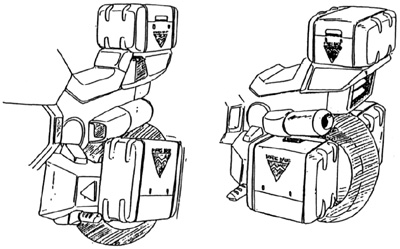 (lower unit in picture). (lower unit in picture).Size: 18 inches tall by 20 inches wide by 18 inches deep. MDC: 30. Note: Destruction of the CA-105 will result in an explosion that does 1D6 times 10 M.D. to all objects in a 10 foot radius. The cyclone the CA-105 is attached to is automatically considered destroyed (engine system is wrecked), though the pilot will usually be protected by the Cyclone's armor. Alternative Uses: The CA-105 can also be used to power just about anything that uses a battery; Special Battalion Power Armor was powered by these, until the Council specifically took the power armors back, as are many prison power armors; The Battalions also use a larger version (the -131) on their mobile home units (these are built studier, and less likely to develop issues). | MDC: 30. Height: 3 feet, 6 inches. Width: 4 feet. Length: 5 feet, 4 inches. Weight: 50 lbs. empty, 250 lbs packed with medical equipment. | Cargo: If the medical supplies are removed, the Hos-Box can carry approximately 16 cubic feet of material (4 times 2 times 2 foot storage compartment) and up to 400 lbs. It is not uncommon to see a Hos-Box doing duty in the wastelands as a cargo carrier. | |||||||||||||||||||||||||||||||||||||||||||||||||
| The CA-101 was conceived and developed for the Icarus Mission by REF Intelligence, who wanted a quick and quiet way to land cyclone-clad agents on Earth to spy on Invid fortifications and troop movements. The result of their research was an external device that could allow a cyclone pilot to deploy high in the atmosphere (or even in orbit) and reach the ground without burning up in reentry. The CA-101 initially looks like a large box with thrusters that attaches to the back of any model cyclone like a backpack. In use, the cyclone rider is deployed at high altitudes and uses the cyclone's thrusters to begin descent toWards the Earth. Then the pilot turns around so his back is facing the ground, and activates the CA-101. The pack immediately deploys a series of canvas balloons that form an umbrella-shaped disk on the back of the cyclone. This umbrella is made of heat resistant materials and shields the cyclone pilot, his mecha, and his equipment from damage during reentry. The thrusters on the CA-101 are used to slow the cyclone's descent. Once the cyclone is low enough in the atmosphere, the CA-101 automatically jettisons the balloons and deploys a parachute to safely land the cyclone on the ground. The CA-101 contains chemical fuel and high-power batteries to power both its onboard computer and the cyclone's life support systems, so the entire procedure can be done while the cyclone's protoculture engine is turned off, making the cyclone essentially invisible to Invid scanners. The CA-101 was a tremendous success, and was used extensively during the Third Invid War once the REF discovered that it was virtually impossible to penetrate the Invid space defenses with their starships. During the War Beta fighters would be loaded with Cyclone troopers and then fly close enough to the Earth to deploy the troopers, and then rocket away from earth before the Invid Space Troopers could catch them. Thousands of cyclone riders managed to land on Earth this way during the War. The CA-101 can be used by any cyclone, old or new, without penalty. NOTE: The CA-101 can be used only in battloid mode! Should the cyclone switch to motorcycle mode then the CA-101 will automatically pop off the back of the mecha. | 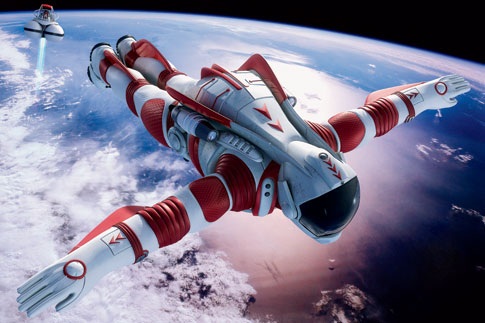 | ||||||||||||||||||||||||||||||||||||||||||||||||||
| Model Type: CA-101 Cyclone Re-Entry Shield. Class: Disposable Re-Entry Shield. Crew: One fully-clad Cyclone Rider. M.D.C. By Location: | |||||||||||||||||||||||||||||||||||||||||||||||||||
| Main Unit Thruster Heat Balloon Parachute | 25 10 2 1 | ||||||||||||||||||||||||||||||||||||||||||||||||||
| NOTE: Destroying any part of the CA-101 will render the entire unit useless. | |||||||||||||||||||||||||||||||||||||||||||||||||||
| In addition to the weapons systems themselves, there are many accessories that are used with them. | |||||||||||||||||||||||||||||||||||||||||||||||||||
 A general-purpose sniper scope First developed for the T-21. It snaps in the top, and can be used as a quick-sight when closed, or for clarity up to 50 miles when fully extended (far in excess of the gun's range) with a maximum magnification of 100 power (the object, as seen, is 100 times as big through the scope as without) The scopes are pre-fitted not only with ballistic drop compensators (BDC; allows the user to adjust for battlefield variables and the behavior of rounds in flight), but also Windage At Distance Indicator (WADI), which shows the wind speed and distance at the desired distance, Humidity At Distance Indicator (HADI) which shows the humidity at the distance desired, Curvature At Distance Indicated (CADI), which indicated in MM or hundredths of inches the degree of terrain drop or rise at the distance desired (which can effect the shot by way of gravitational pull), and built-in rangefinder (uses a green laser, which is usually not screened for, and therefore not noticed on defensive shielding; it's also a low-power laser, so it shouldn't set off the sensors anyways). A secondary purpose for the scope is a monocular, used for observation in areas where clear view allows it's use. Though shown on a rifle-mode T-21, it can be used on any UGC weapon except the H-90, M-2 Machine Gun, and PB-22 Particle Beam Cannon; Adaptors are available for the later M-2 and PB-22 (it does have a recoil compensator of its own), but the H-90 still can not utilize the scope. The scope can see clear light, be used as a starlight scope, or can be used with a laser or IR designator. |  The GR-117 is a rather unique weapon system originally designed for the VR-117 Firefly rescue cyclone. The primary "weapon" of the GR-117 is a grappling hook launcher with an extremely strong cable and hook. The grappling hook can be used in a variety of purposes, such as a makeshift crane, cable for pulling, or even for securing loose and crumbling fixtures. It can be used for its original purpose of scaling buildings and walls as well, of course. In addition to the grappling hook, a welding laser is mounted on the module to allow the user to cut through bulkheads and rubble. The GR-117 unit is NOT designed with combat purposes in mind. | ||||||||||||||||||||||||||||||||||||||||||||||||||
| Purpose: Rescue. Effect: Grappling Hook: 5D6 S.D. (not designed to be used as a weapon). Welding Laser: 1D6 S.D., 3D6 S.D., 6D6 S.D., 1D6 times 10 S.D., 1D6 M.D., or 3D6 M.D. per round (the laser has multiple settings for different materials). | Rate of Fire: Equal to pilot's number of attacks. Range: Grappling Hook: 500 ft (150 m) of high-strength wire; 10 M.D.C. per50 feet. Payload: The welding laser draws power directly from the on-board fusion reactor, so it is effectively unlimited as long as it remains attached to the cyclone. The laser is useless if detached. | ||||||||||||||||||||||||||||||||||||||||||||||||||
 Scope co-witnesses are various attachments that allow the scope to effecitively have a second scope; In this example a green sight is co-witnessing the main scope. These can be add-ons or part of the original factory design. Scope co-witnesses are various attachments that allow the scope to effecitively have a second scope; In this example a green sight is co-witnessing the main scope. These can be add-ons or part of the original factory design. | |||||||||||||||||||||||||||||||||||||||||||||||||||
| Purpose: Sniper/Spotter Scope. Operation: Light Wave, Infra Red Energy, or Laser Designators, as well as light amplification. Weight: 10 oz. Overall Length: In it's closed configuration it is only about 4.5" long; Full extension is 24". | Effect: Closed the scope is little more effective than an open sight; Full extension, it can magnify up to 100 times at 50 miles. Maximum Effective Range: 50 miles. Weight: 2.2 oz. | Purpose: Scope Assist. Operation: Typically Laser. Weight: 2 oz. Overall Length: shorter than the scope it's witnessing. | Effect: Closed the scope is little more effective than an open sight; Full extension, it can magnify up to 100 times at 50 miles. Maximum Effective Range: 50 miles. Weight: 2.2 oz. | ||||||||||||||||||||||||||||||||||||||||||||||||
| Spotter Scopes are used for wide angle view to close up view switches quickly. These are typically used by senior snipers for spotting targets and giving the junior partner (the shooter) targeting information. Straight line and down-angle versions are available, and all UGC issued spotter scopes include telemetry data needed to complete the mission and are thinking-cap ready, with built in redundant adjustments knobs. |  | 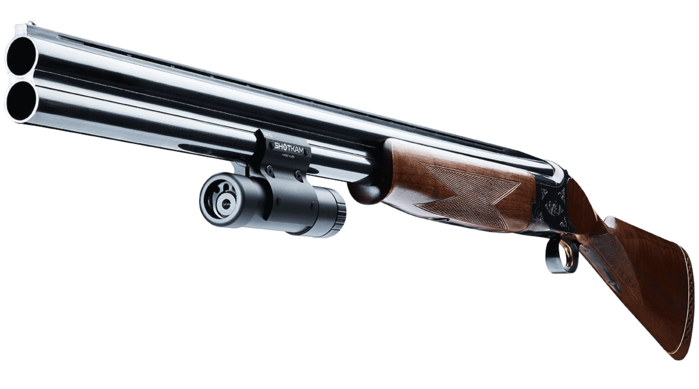 Records your activites to show others what you did at the muzzle point with a camera. Most are easy to install with a quick release that removes the camera in seconds; Shock-absorbing system prevents recoil damage and can be mounted on any side of your gun. REF weapons don't need the mount, since UGC weaps are built with a camera already mounted (as are helmets, goggles, etc.), but civilian weaps usually are not. Most law enforcement agencies add a camera if it wasn't already there and are designed to automatically shut down when holstered or slung. Records your activites to show others what you did at the muzzle point with a camera. Most are easy to install with a quick release that removes the camera in seconds; Shock-absorbing system prevents recoil damage and can be mounted on any side of your gun. REF weapons don't need the mount, since UGC weaps are built with a camera already mounted (as are helmets, goggles, etc.), but civilian weaps usually are not. Most law enforcement agencies add a camera if it wasn't already there and are designed to automatically shut down when holstered or slung. | |||||||||||||||||||||||||||||||||||||||||||||||||
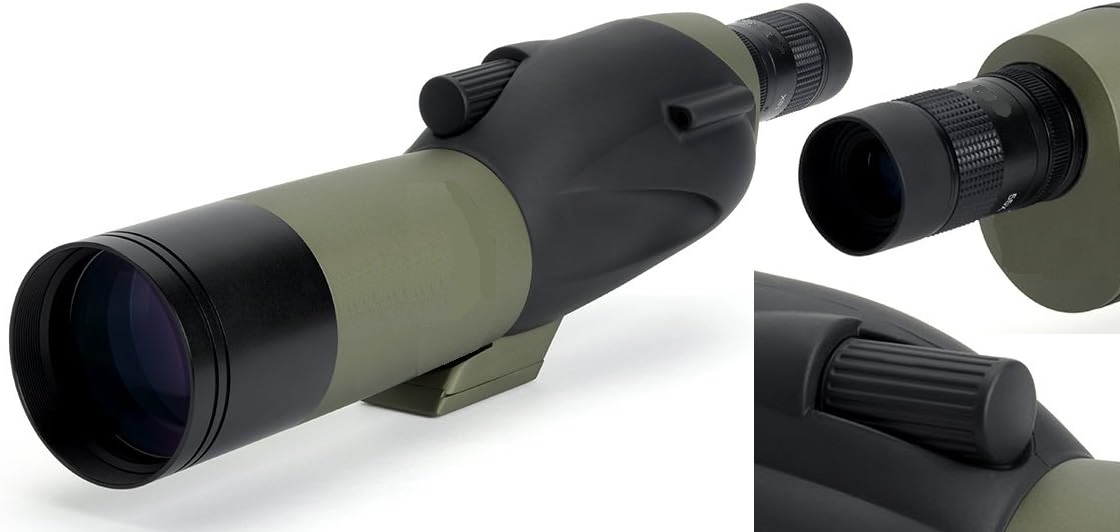 | |||||||||||||||||||||||||||||||||||||||||||||||||||
| Note: Most scopes and all UGC Militry scopes have bluetooth built in, making them effectively gun cams (but not recorders, or limited recorders). | |||||||||||||||||||||||||||||||||||||||||||||||||||
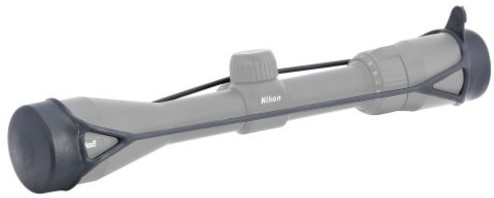 Simple, effective cover stretches over your scope and acts as a moisture and dust barrier. One Size Fits All Standard Rifle Scopes. Millions of shooters appreciate the simplicity, effectiveness and affordable price of this great lens protector. The Bikini was designed for the economy-minded hunter/shooter who prefers a one-piece, quick clearing scope cover. Two pliable rubber-like cups joined by stretch retainers create a tight moisture and dust-proof seal to protect your valuable optics while in storage, transit or in the field. The standard size fits over normal scopes (including ones with built in covers); The Plus size will fit over scopes with add on covers. The V size will fit over mini scopes (such as the A-21). Snipers in particular appreciate the cover for their scopes when transiting to the action area, removing the cover just before setting up. | |||||||||||||||||||||||||||||||||||||||||||||||||||
